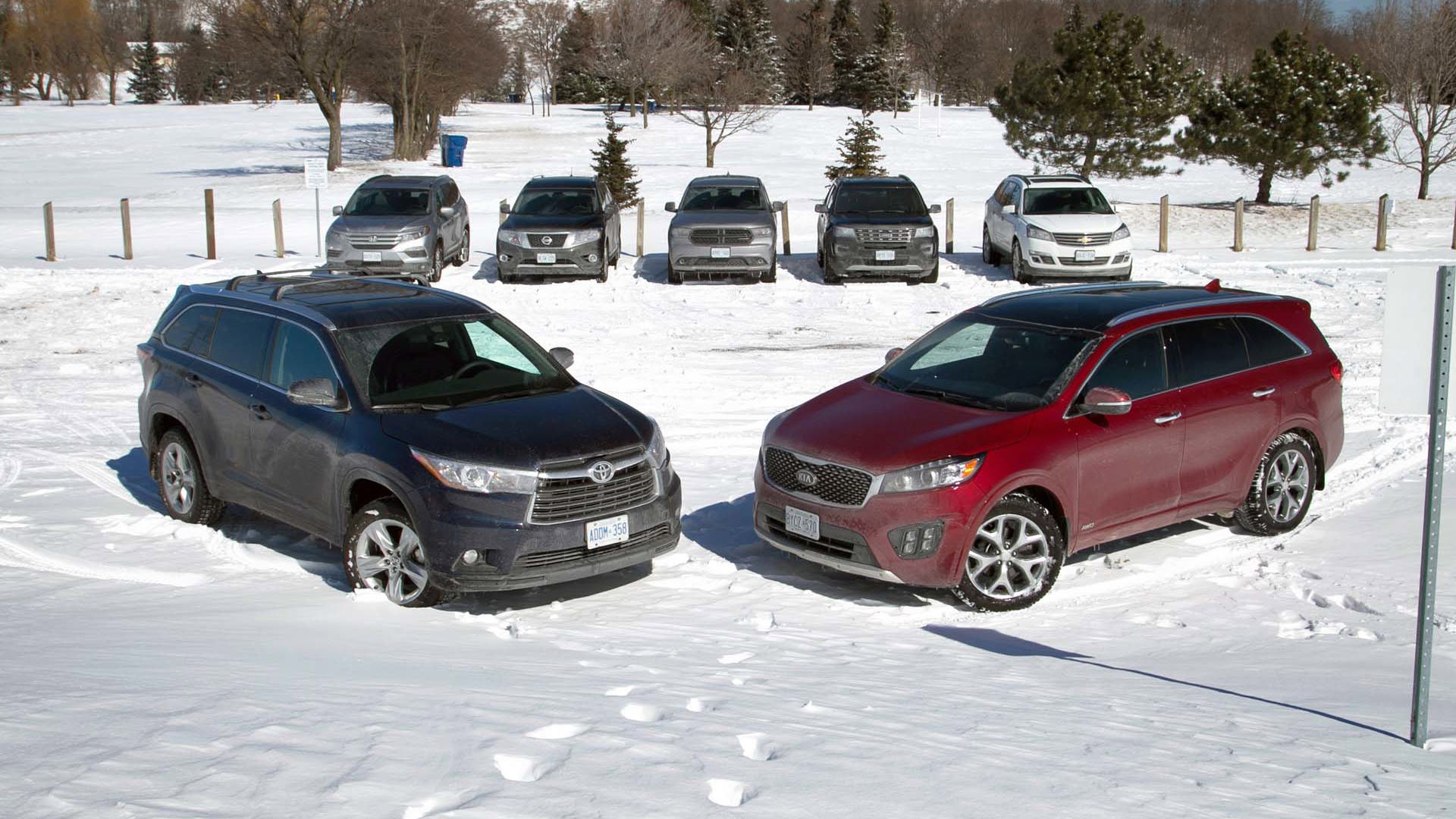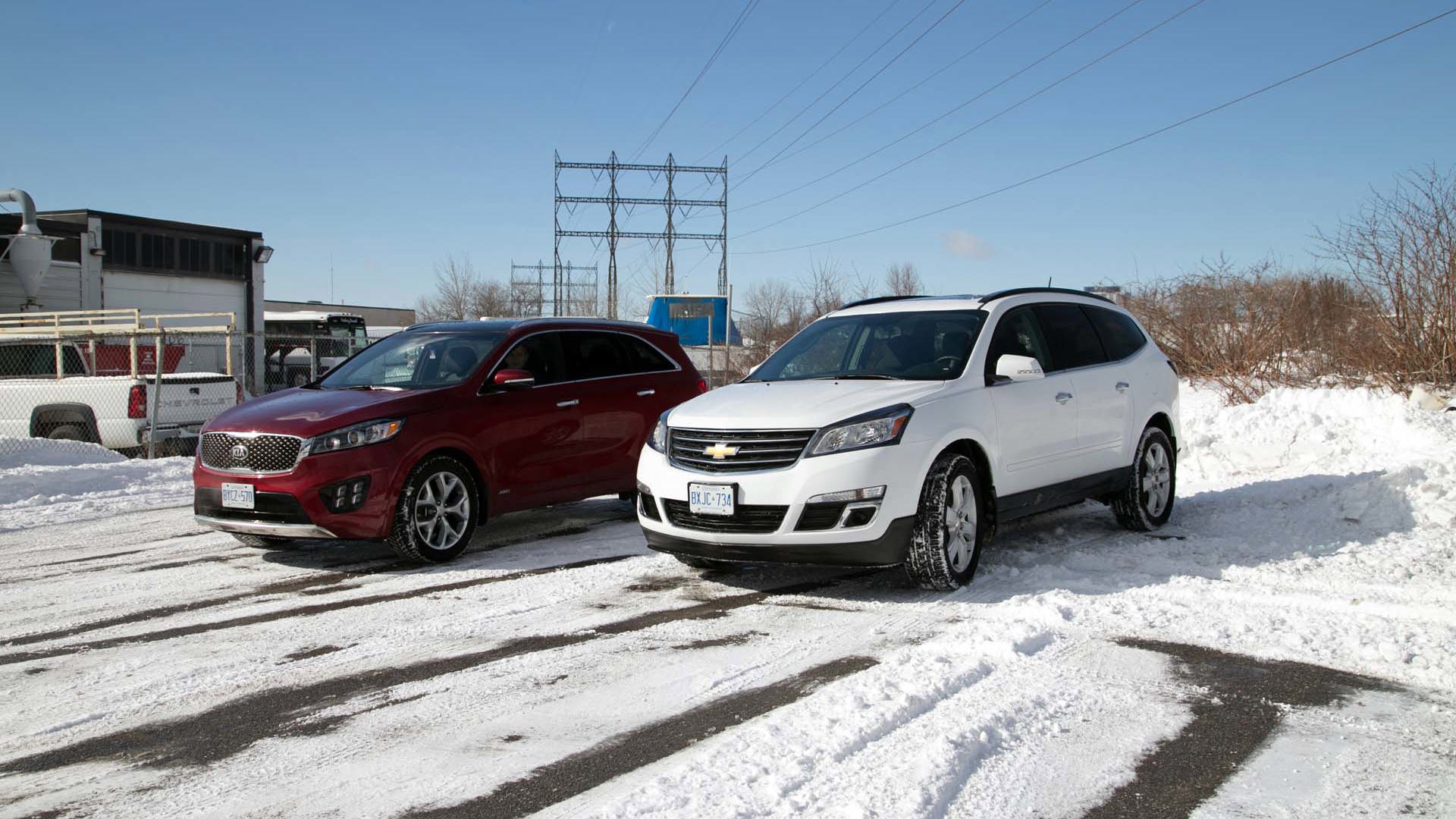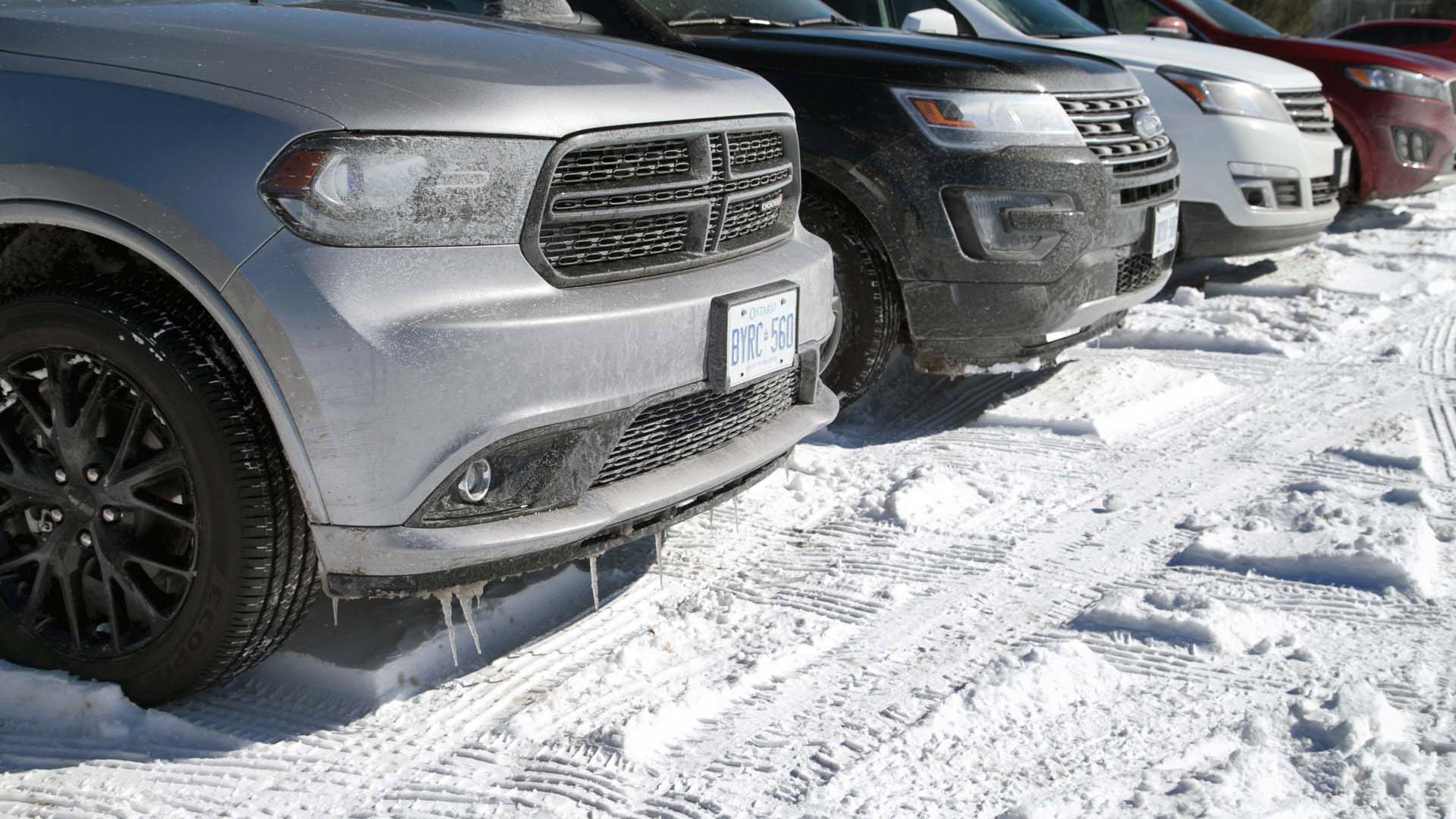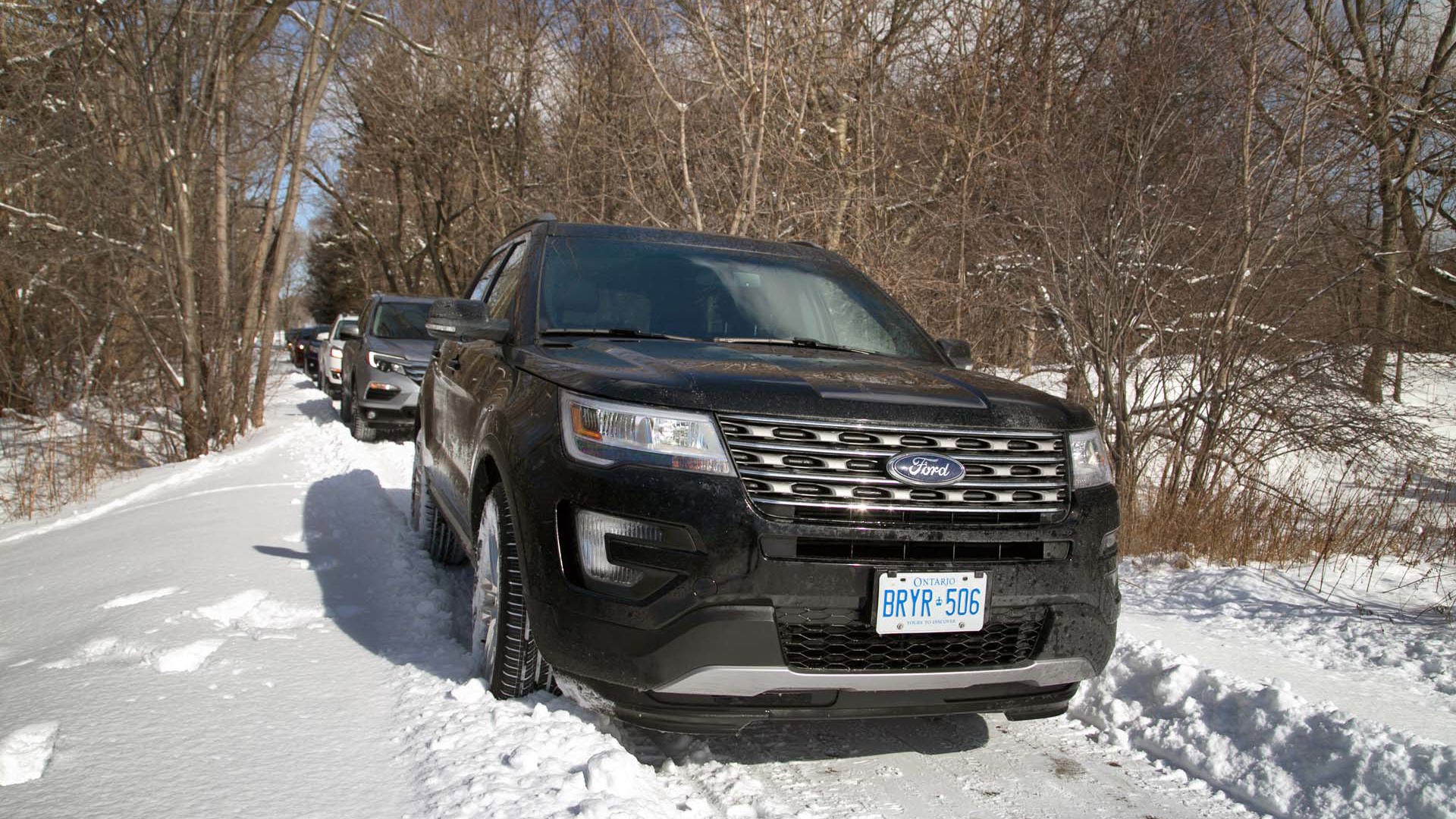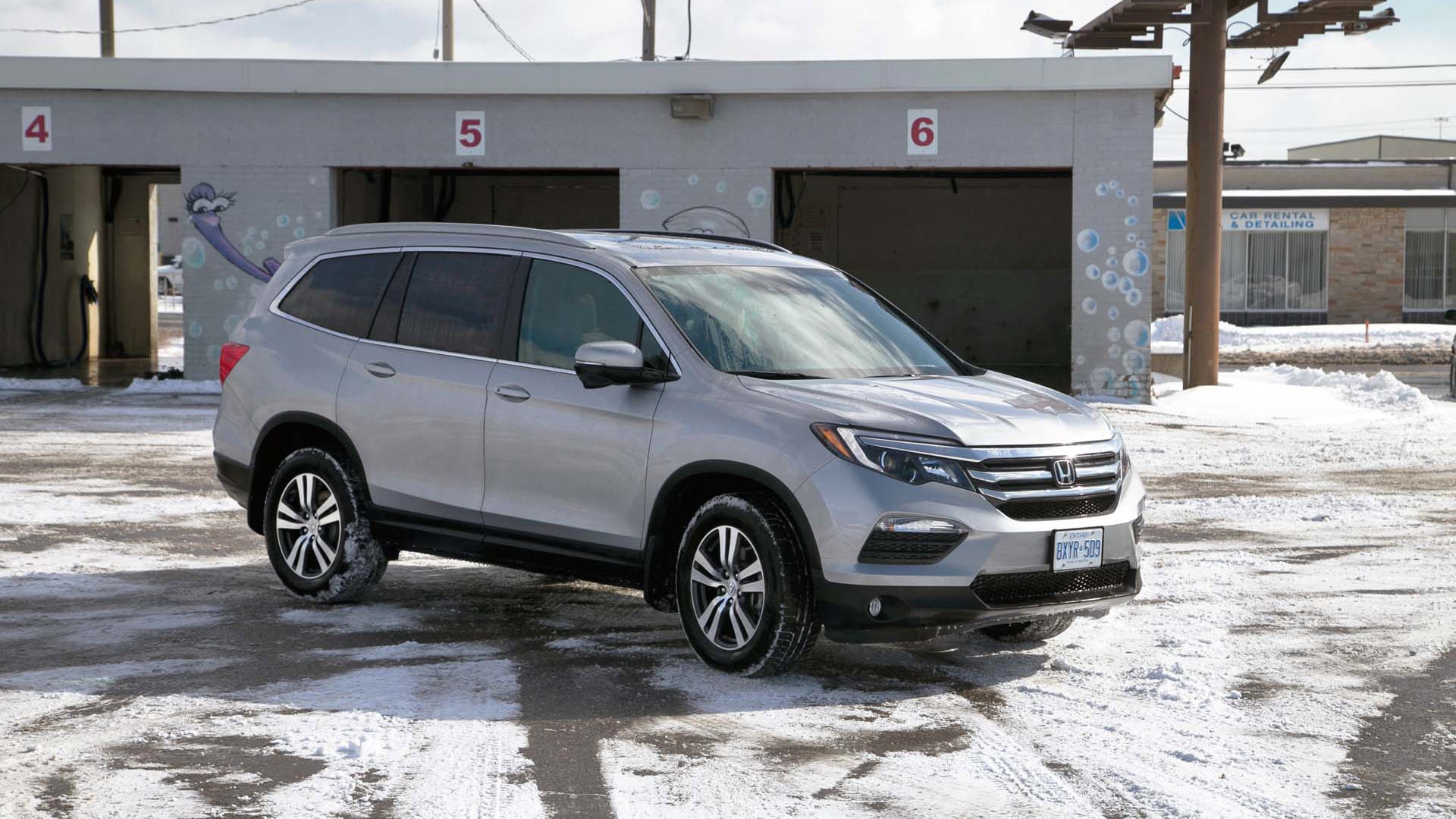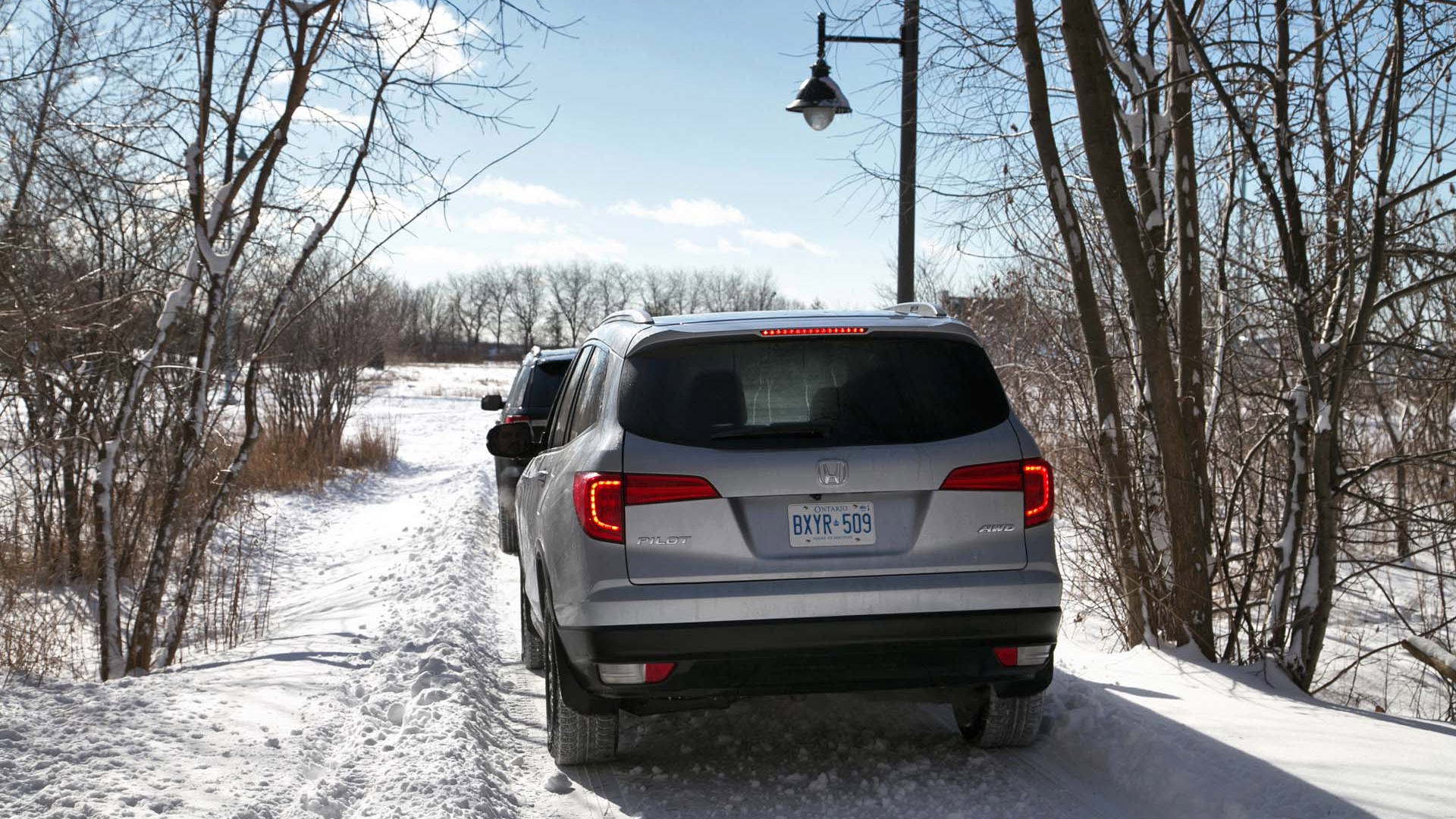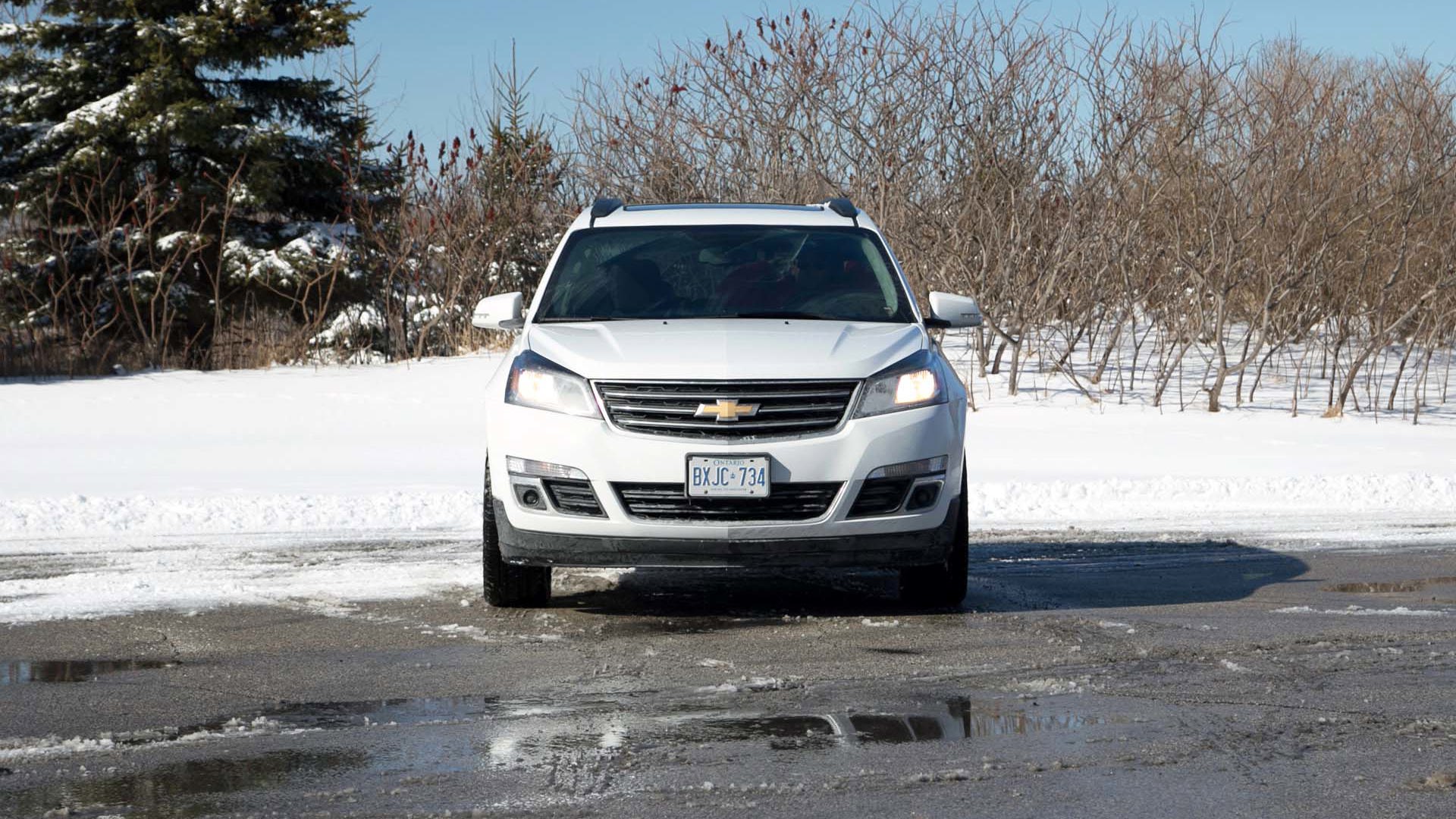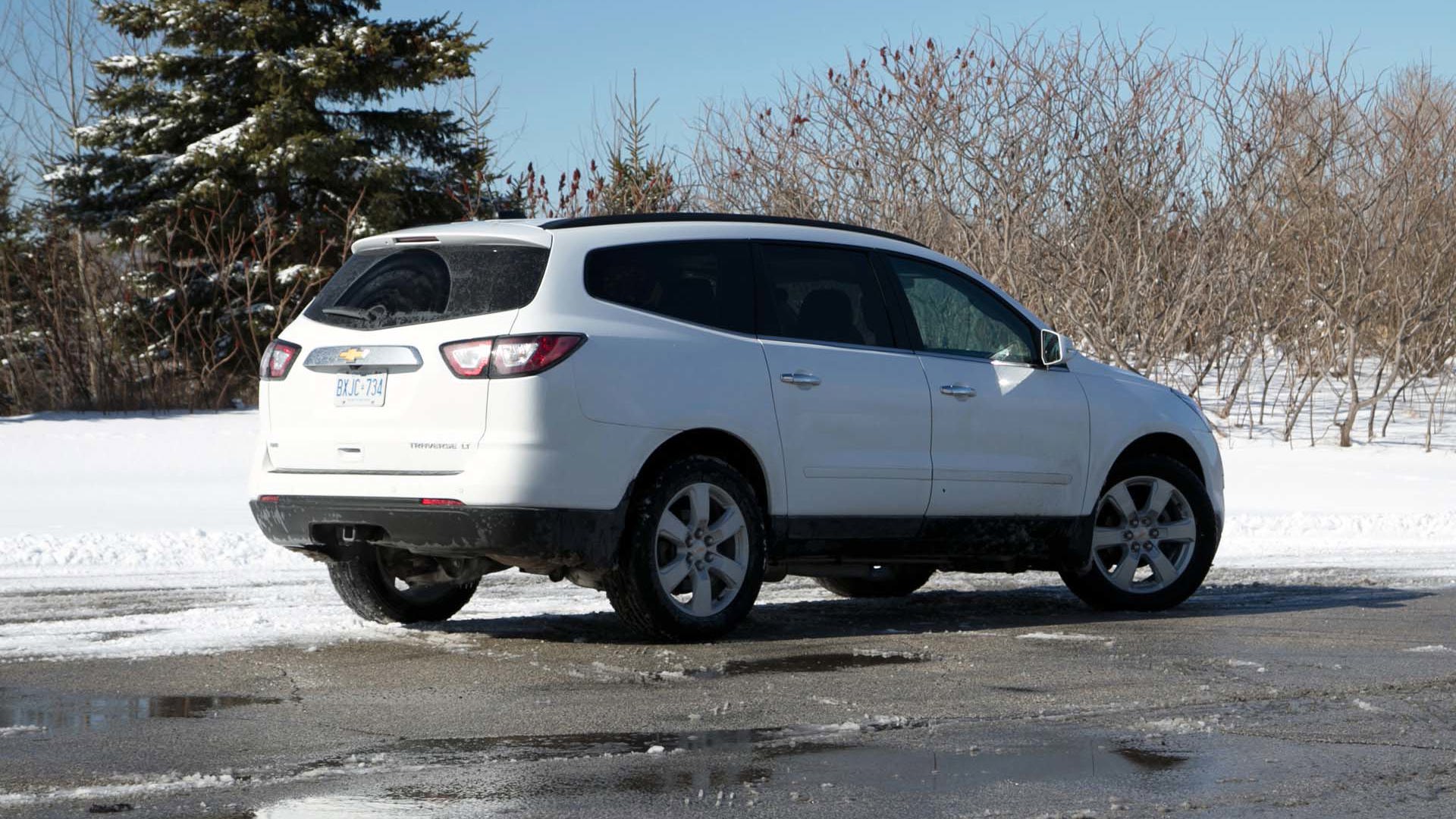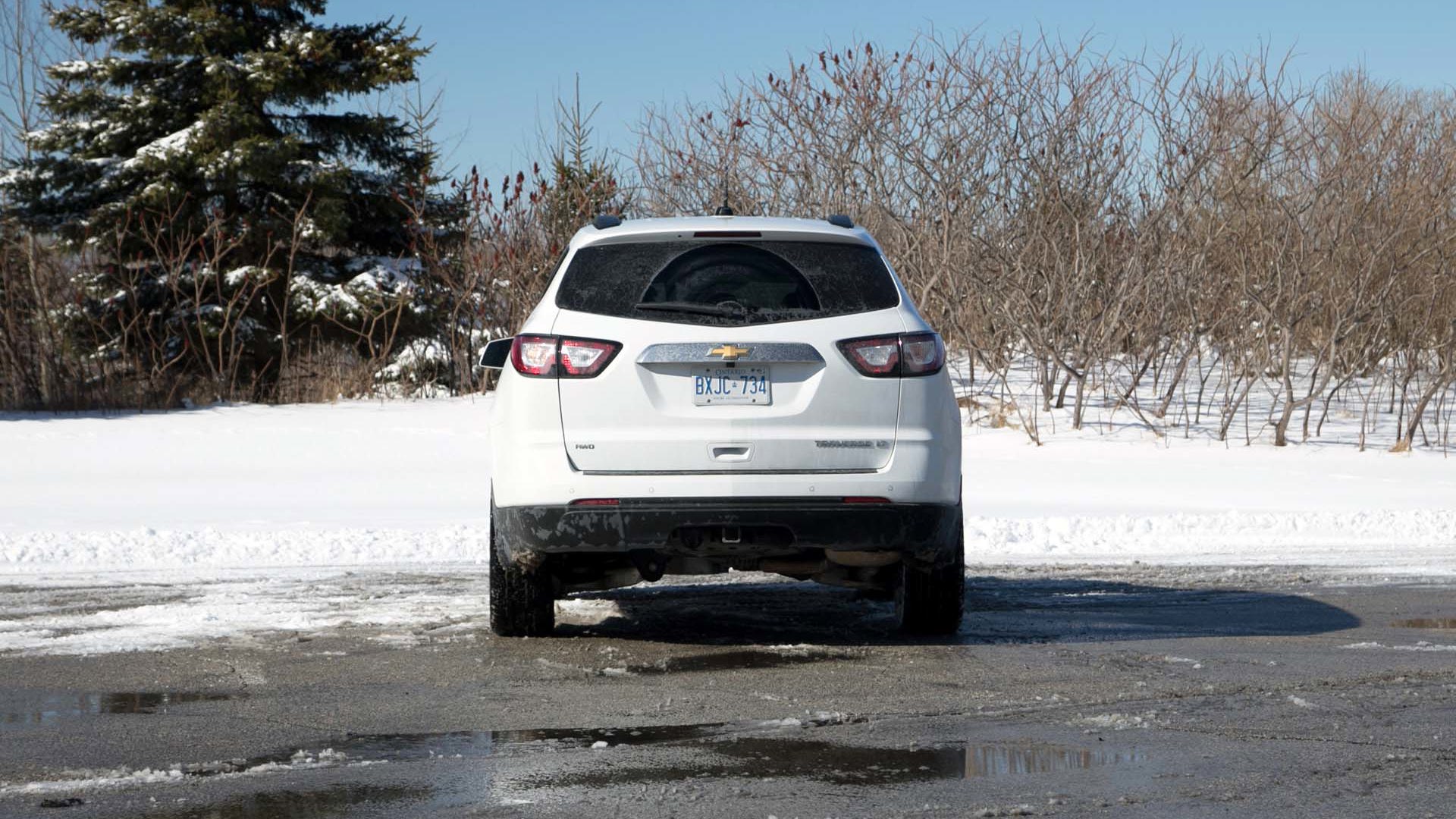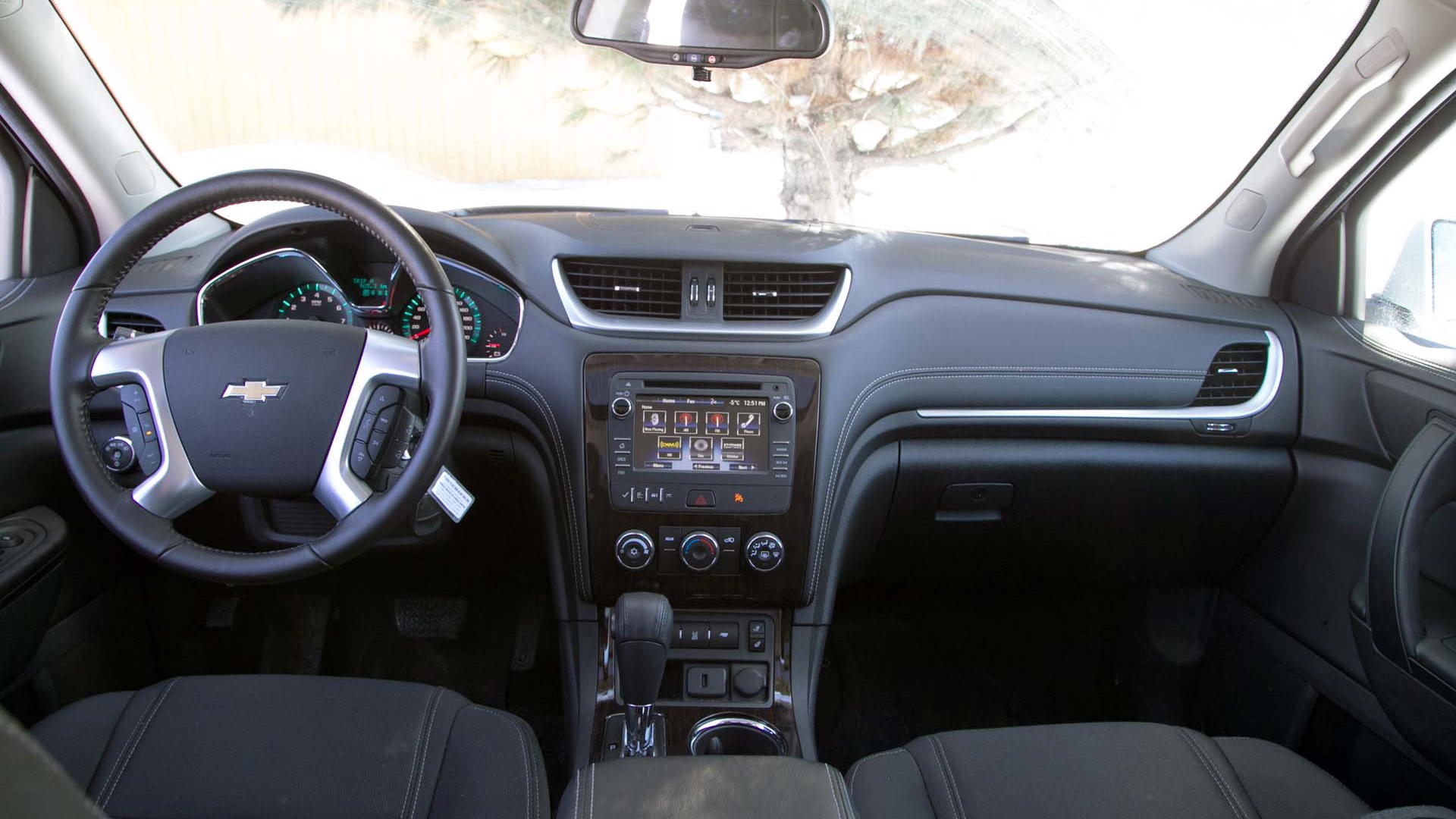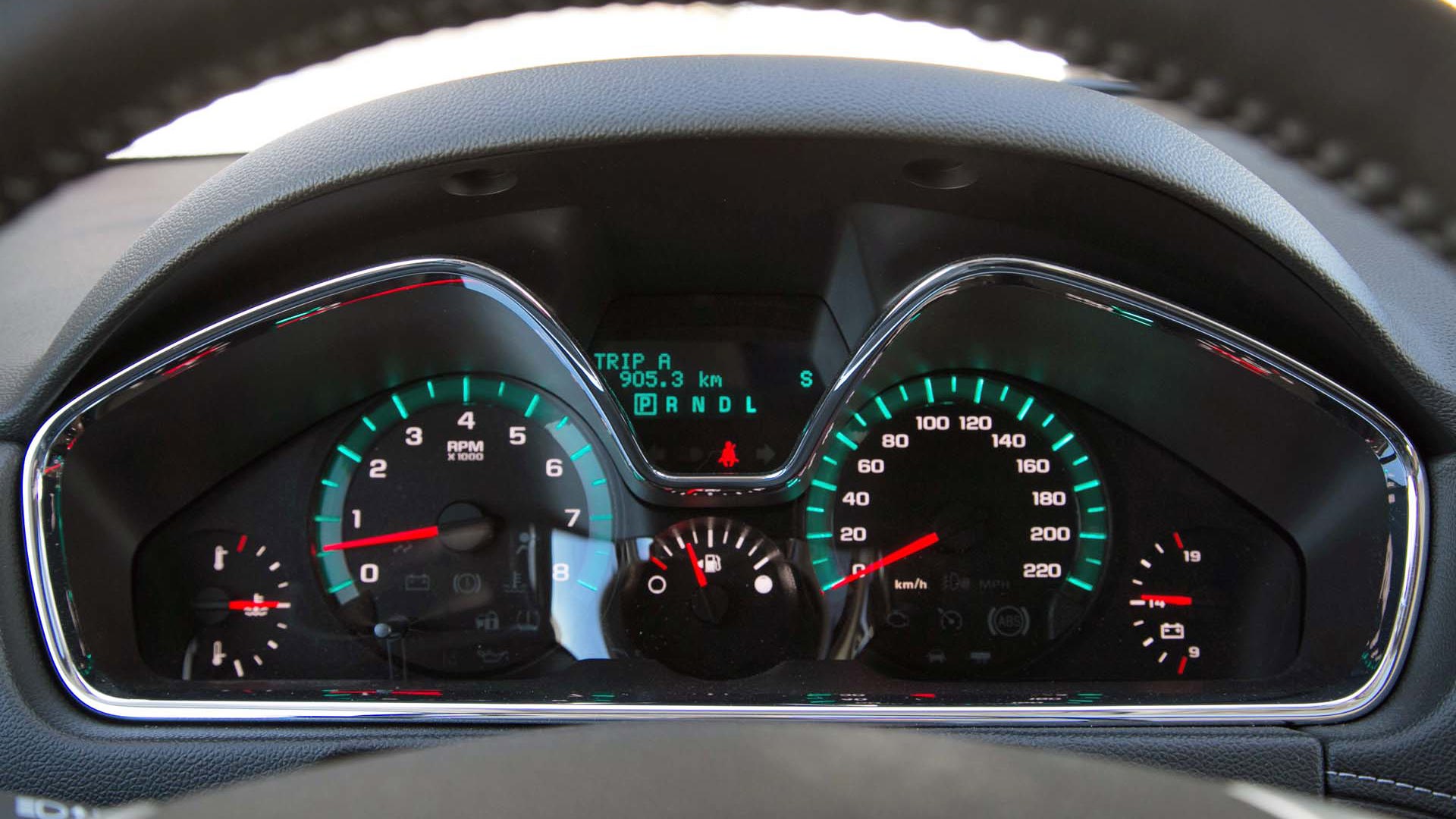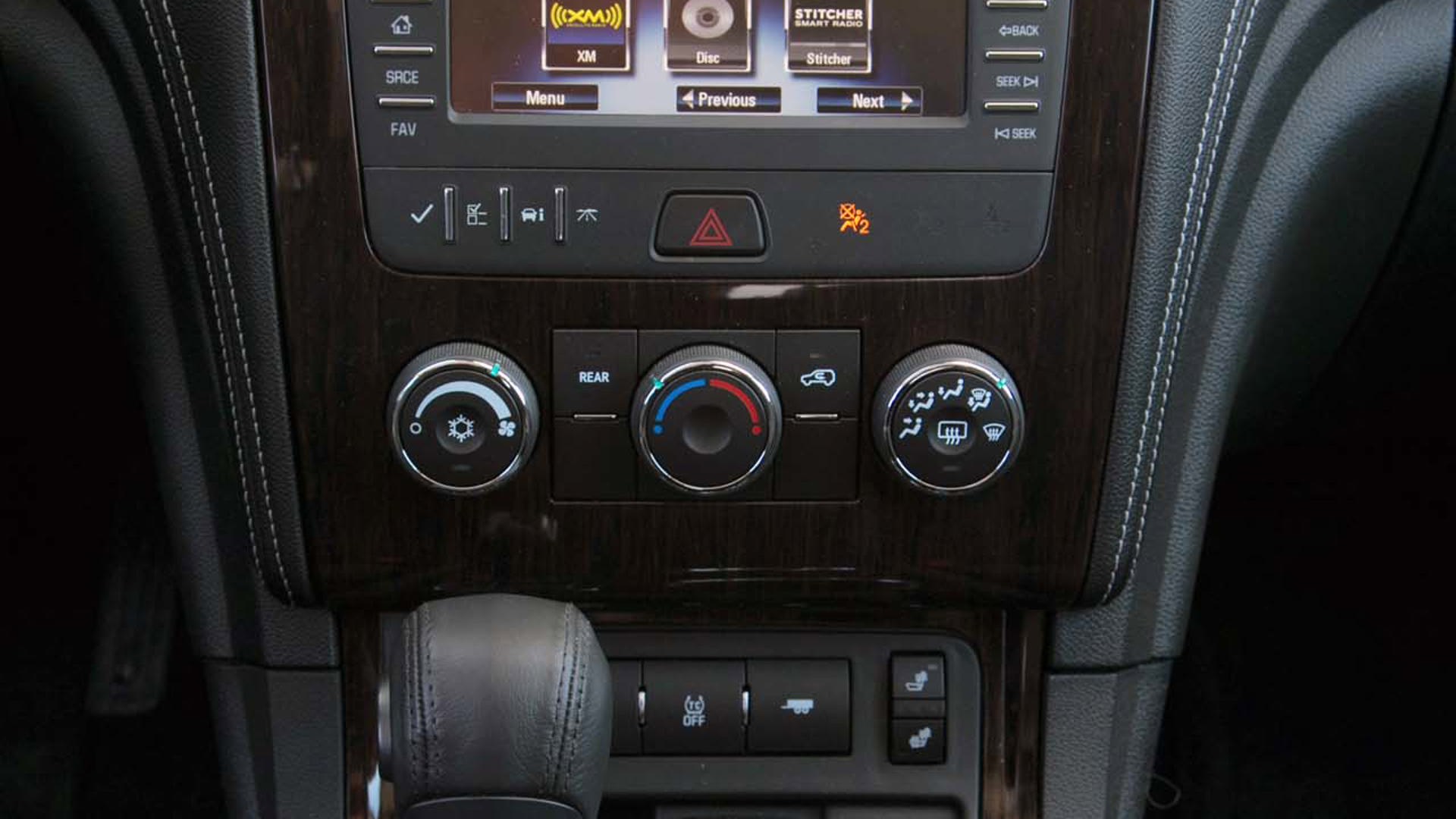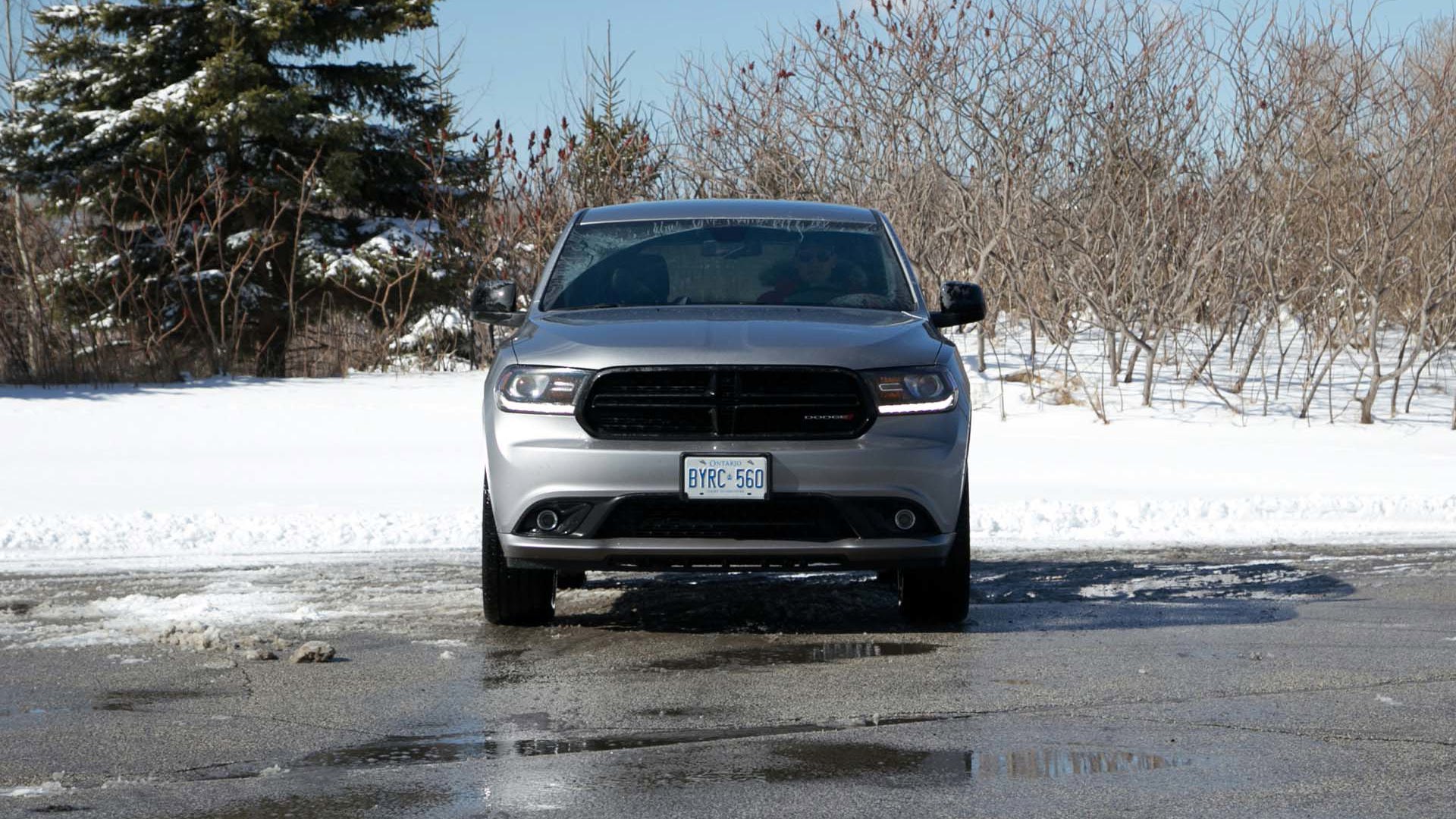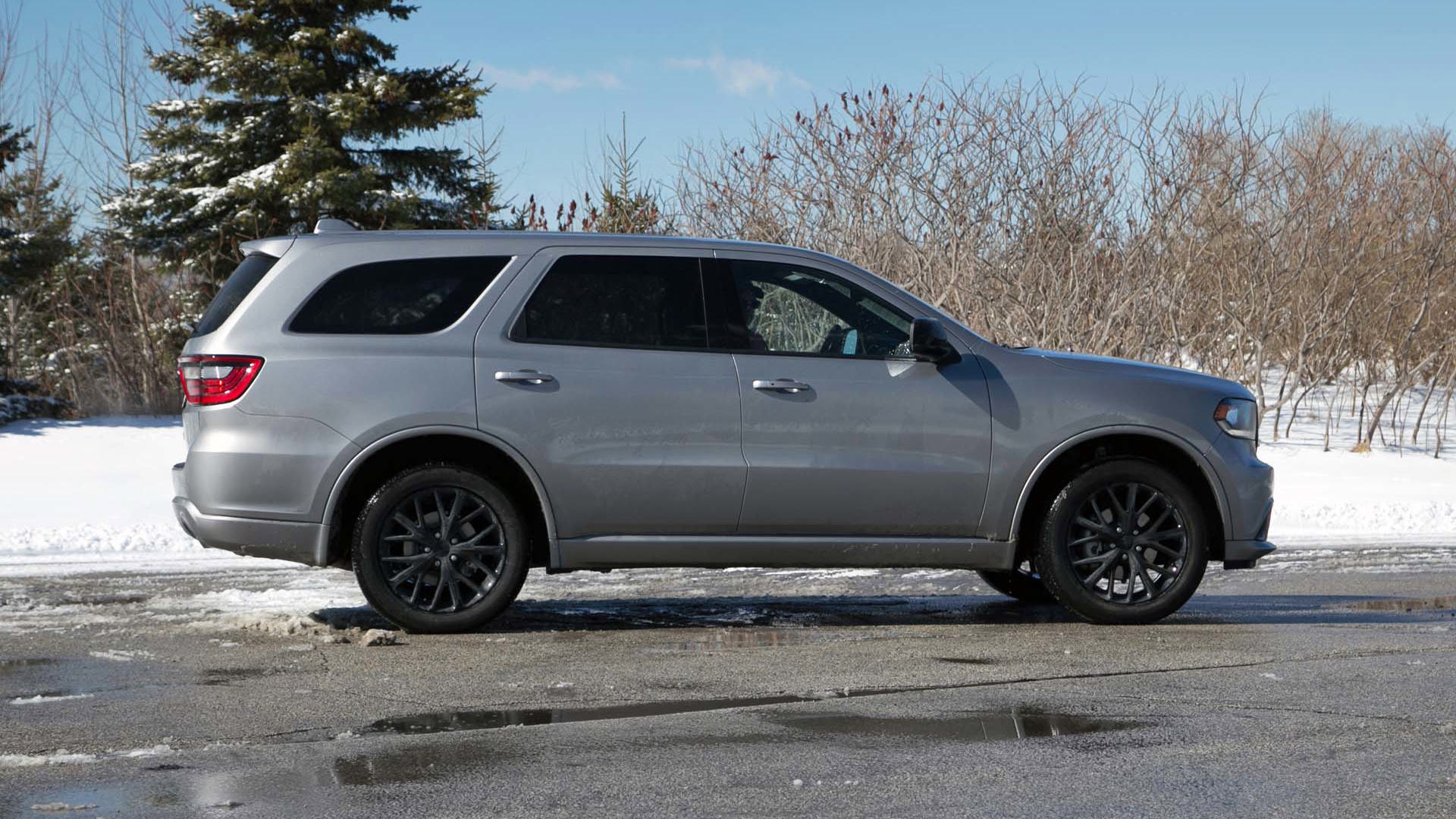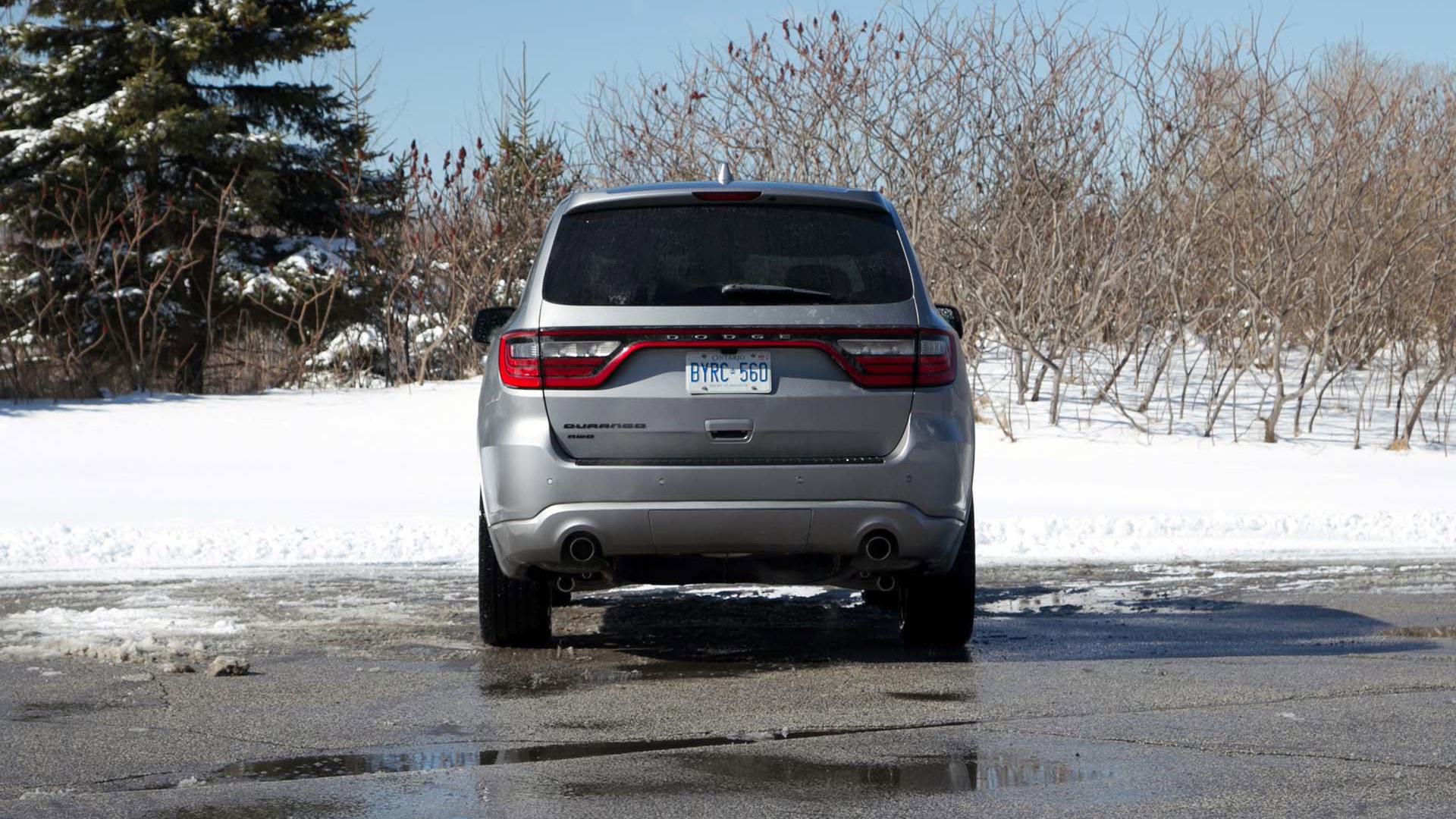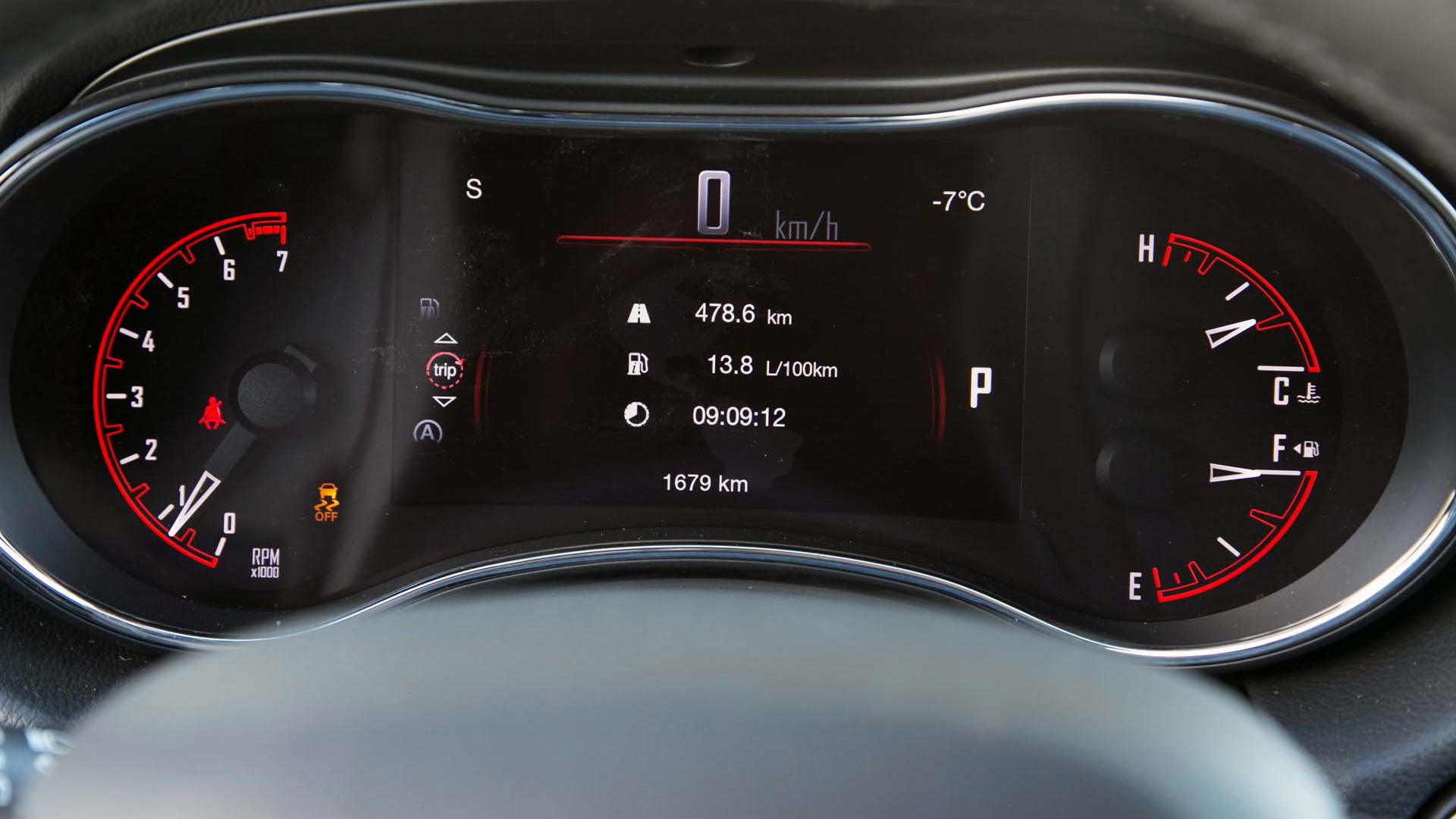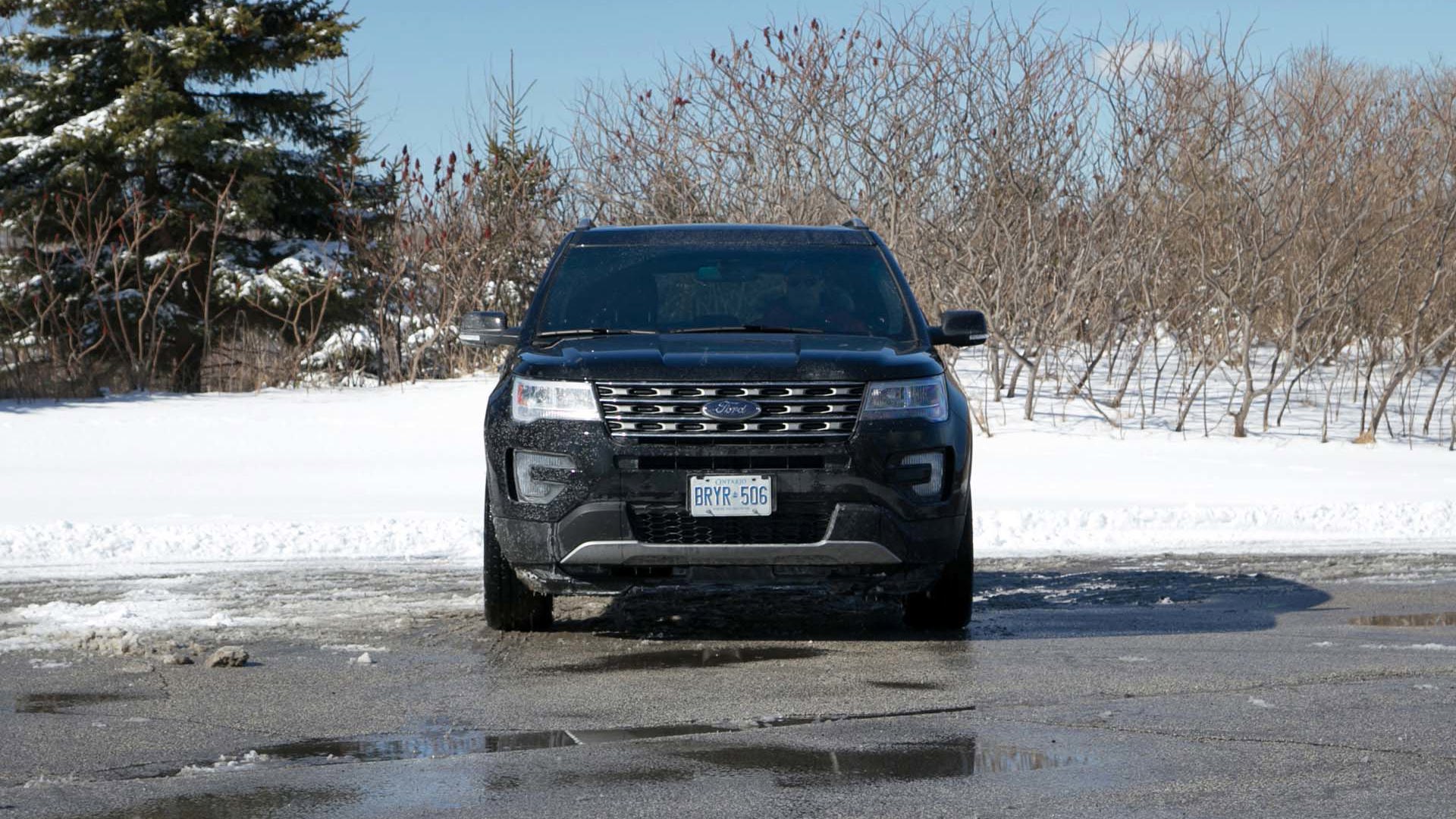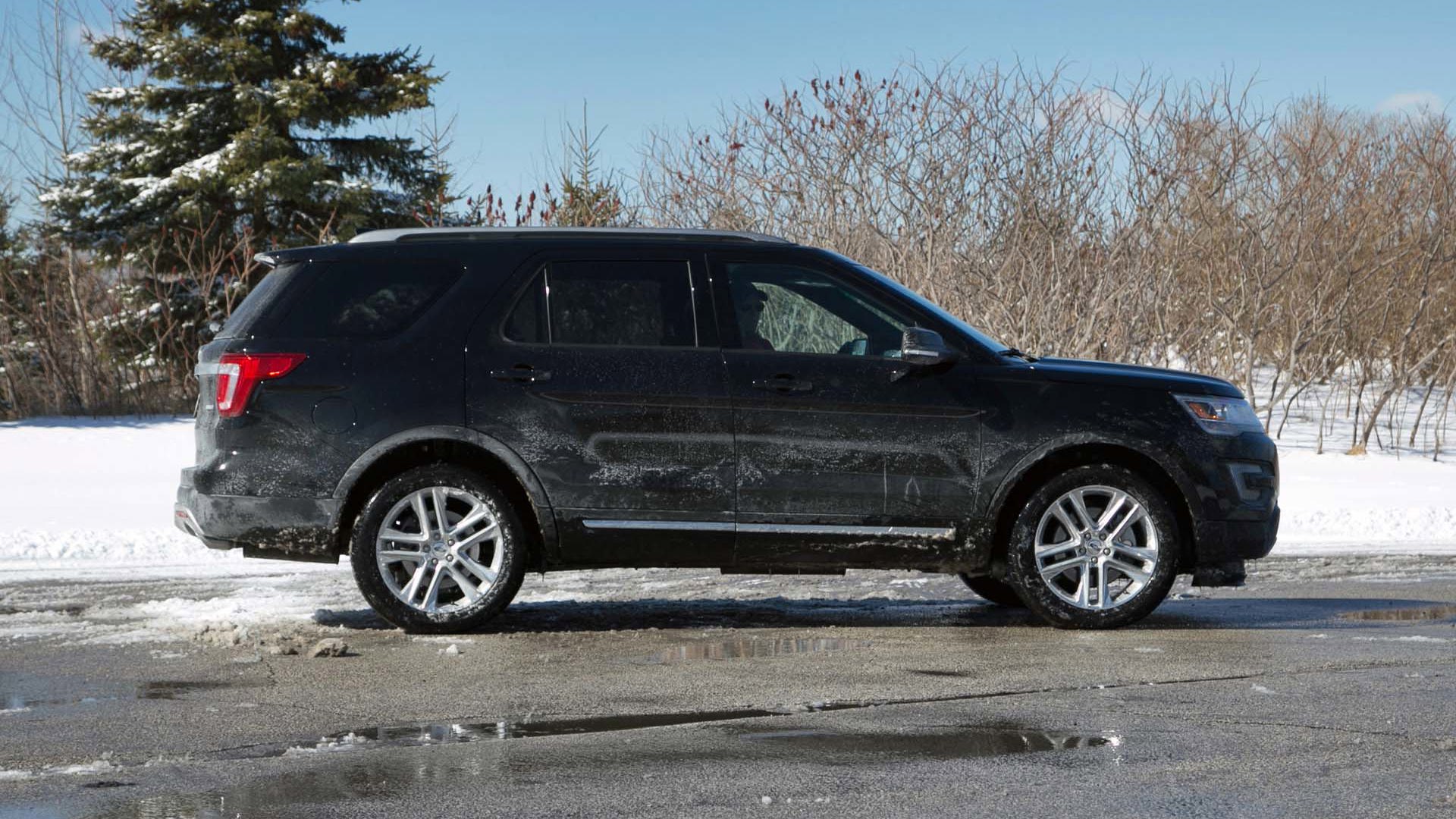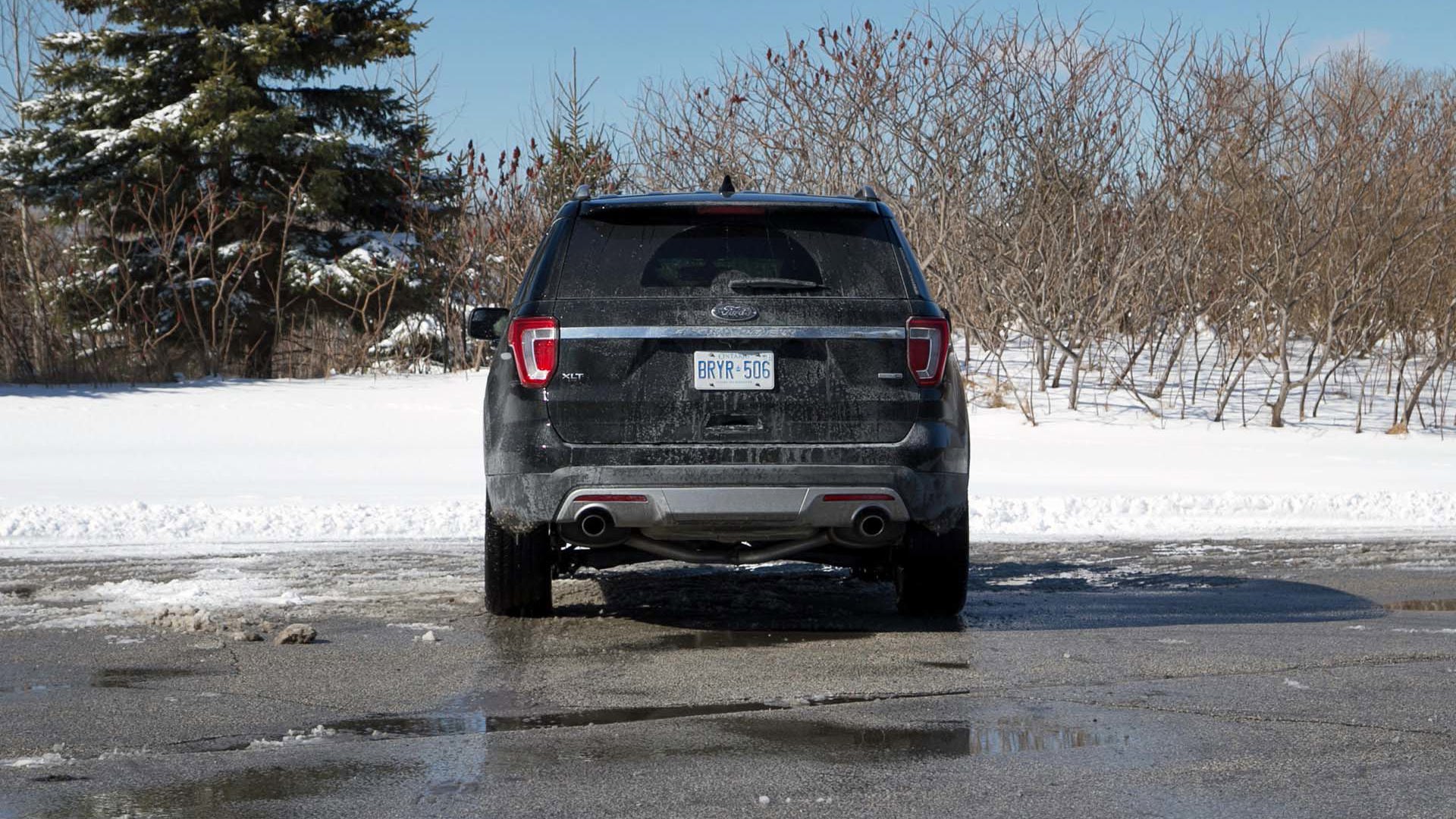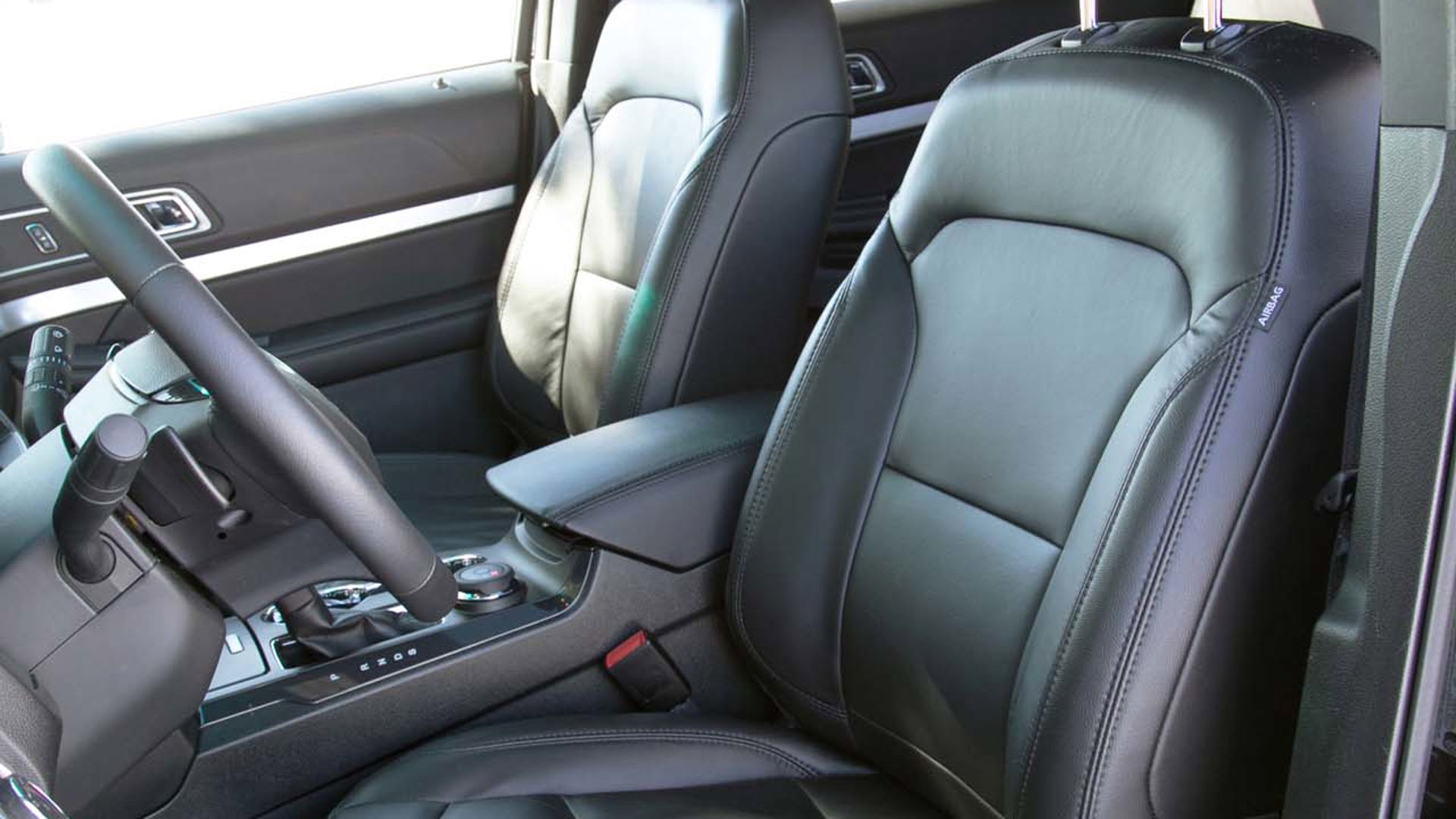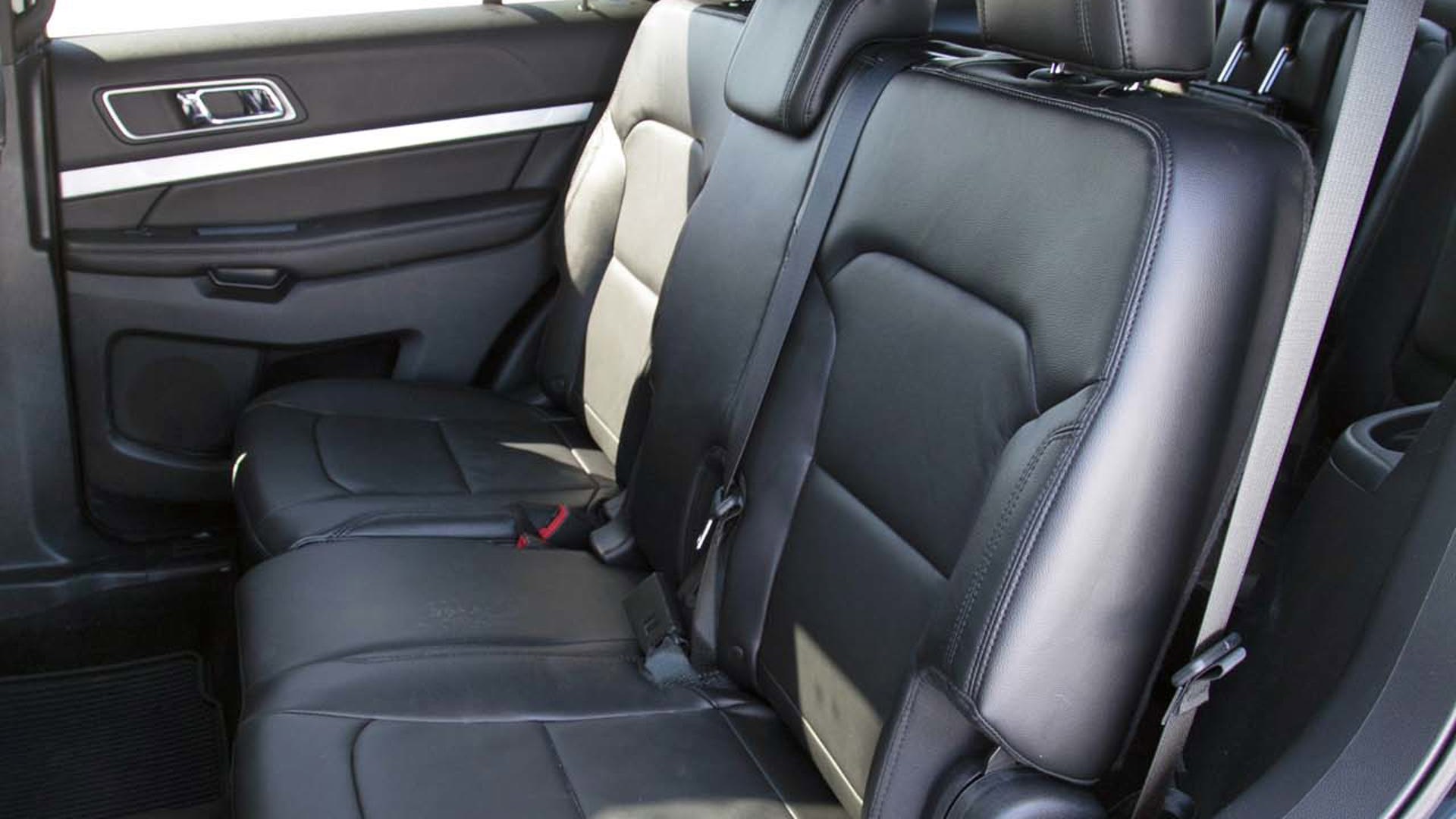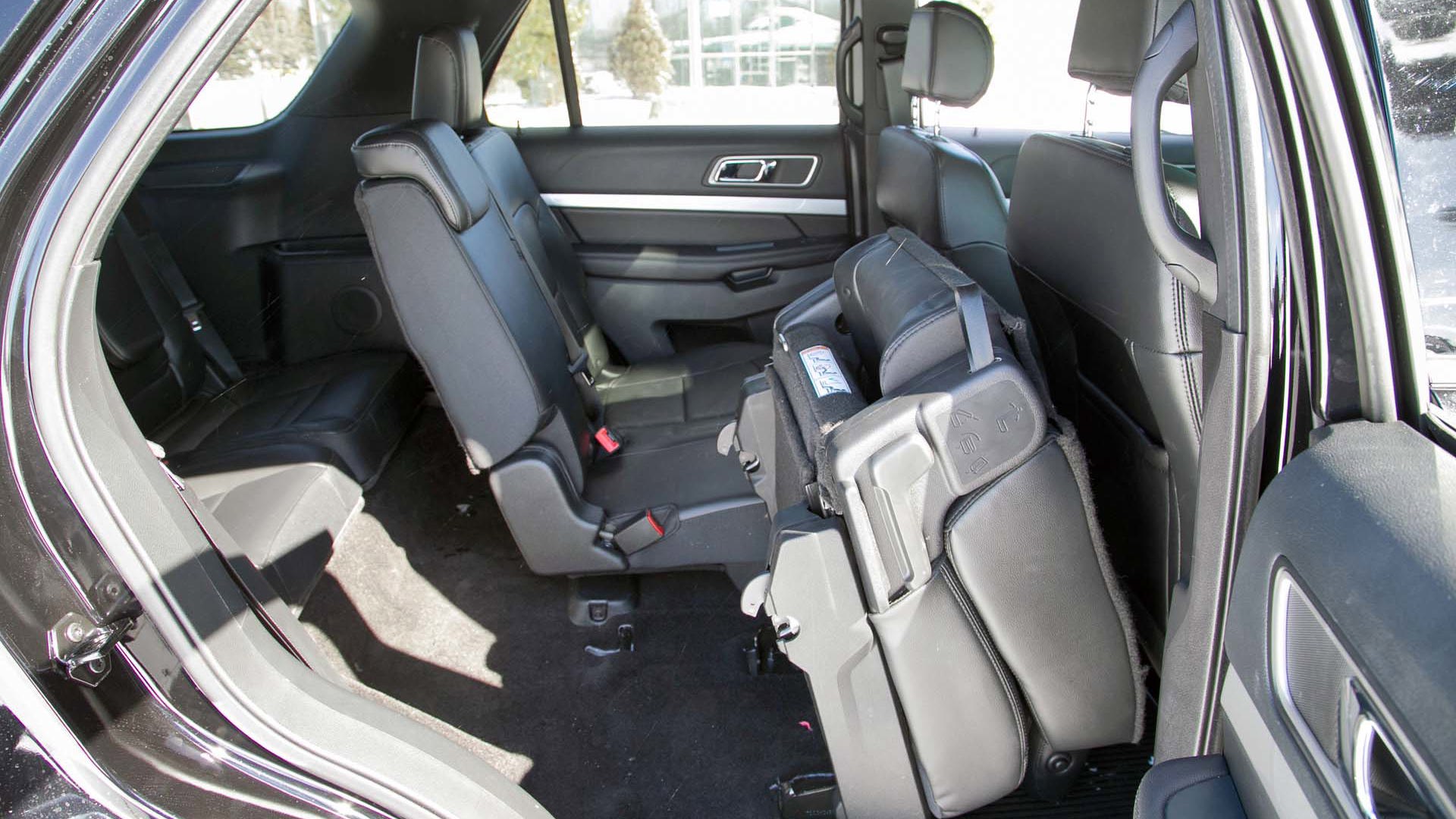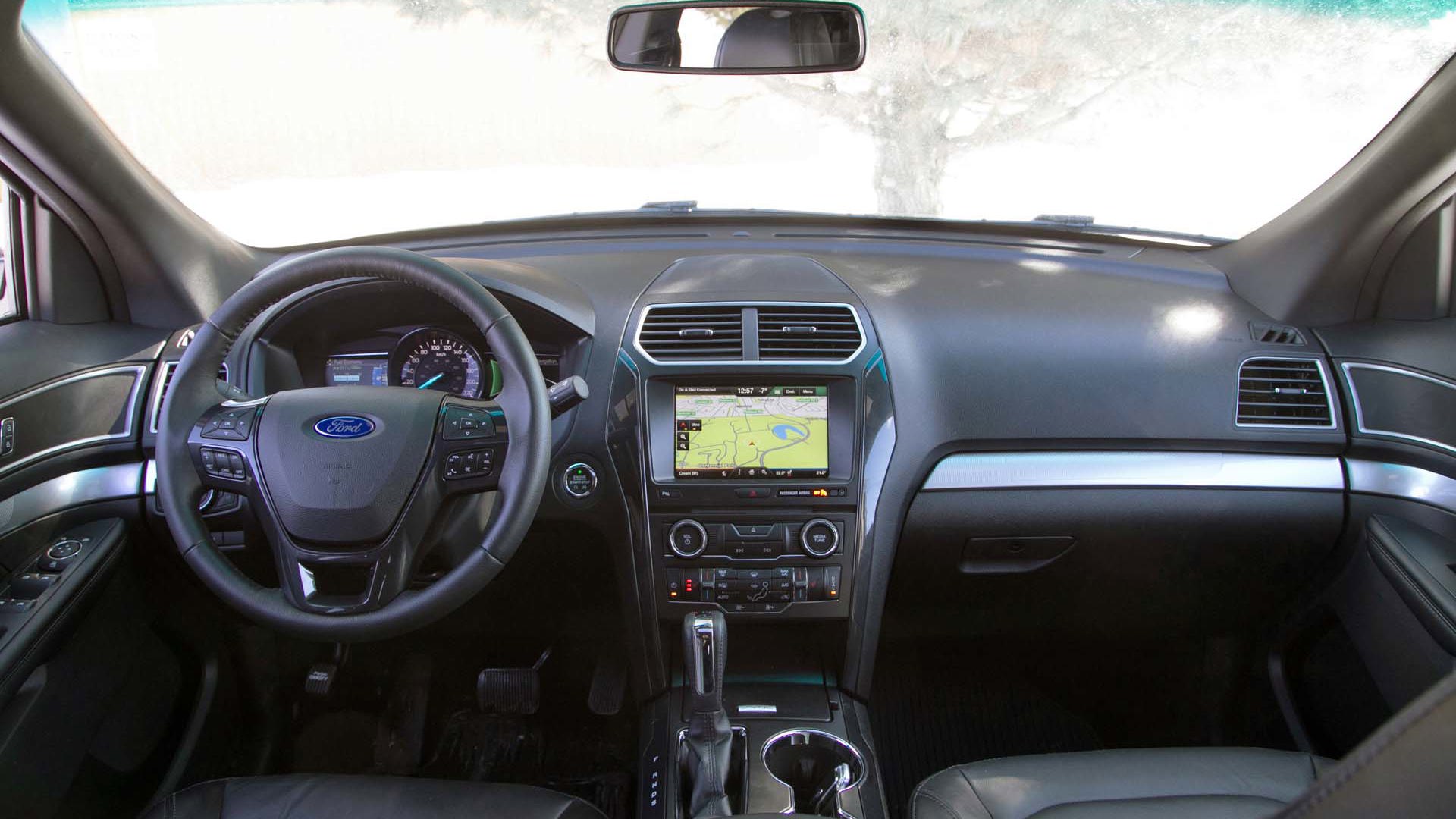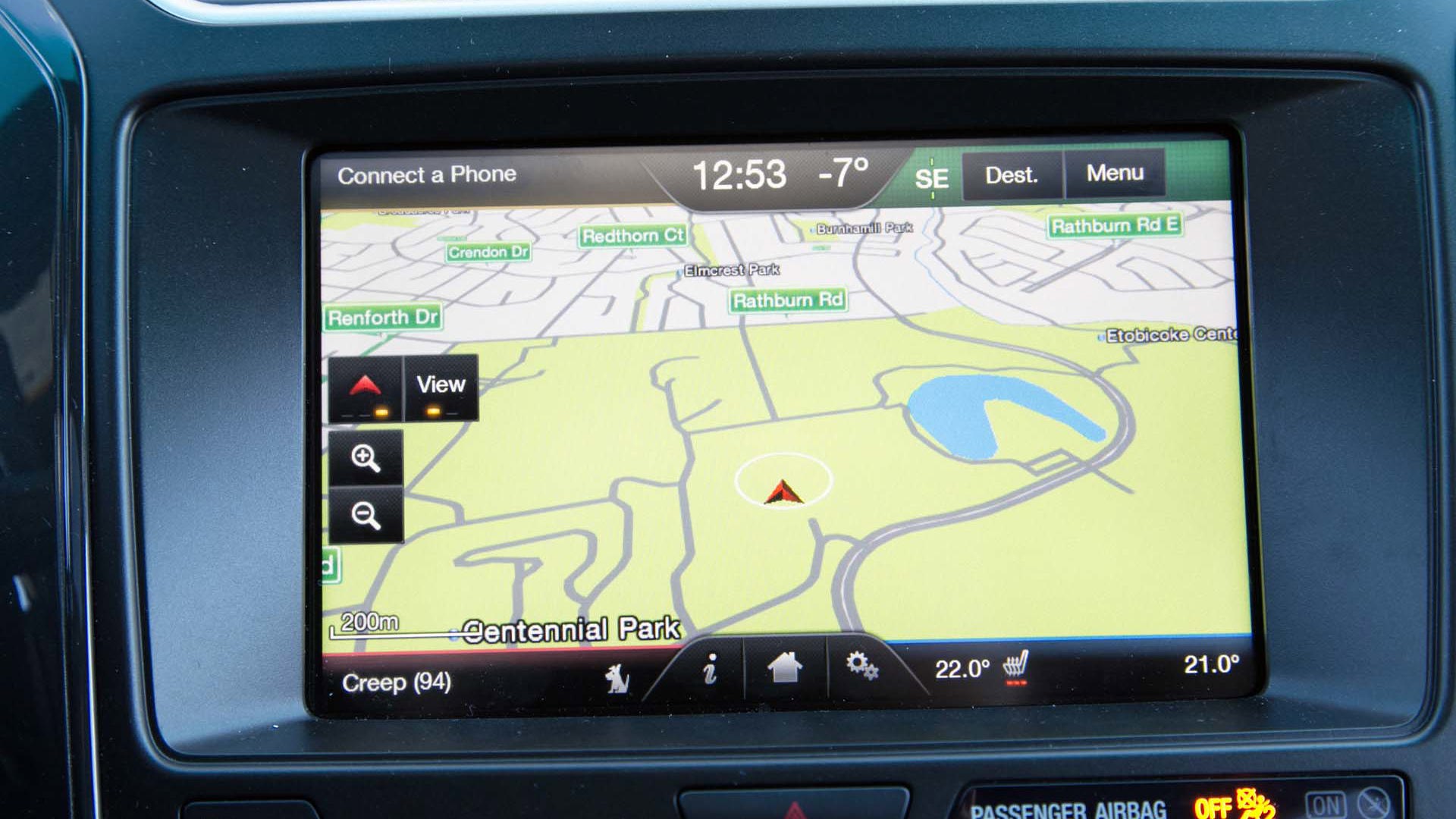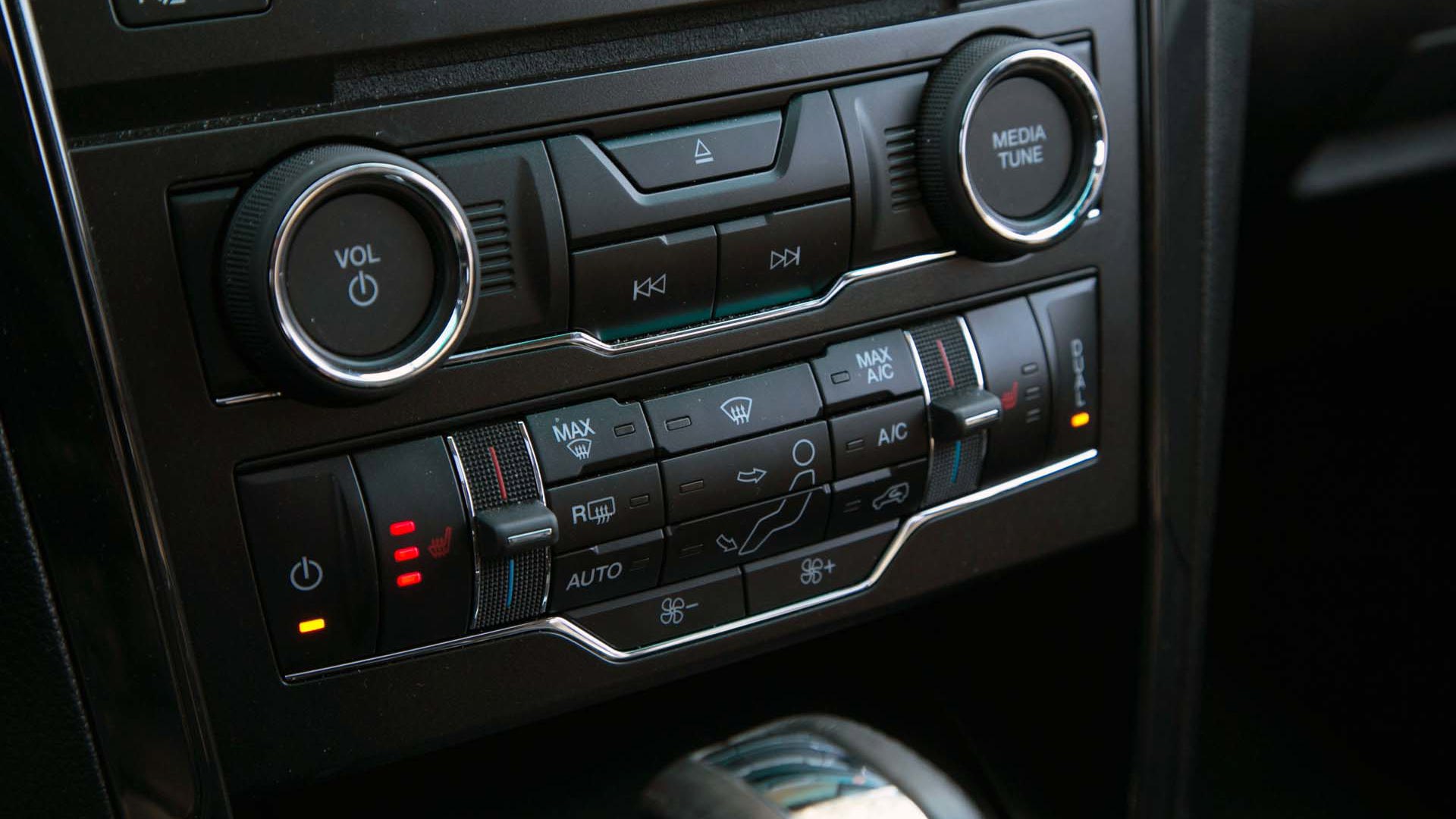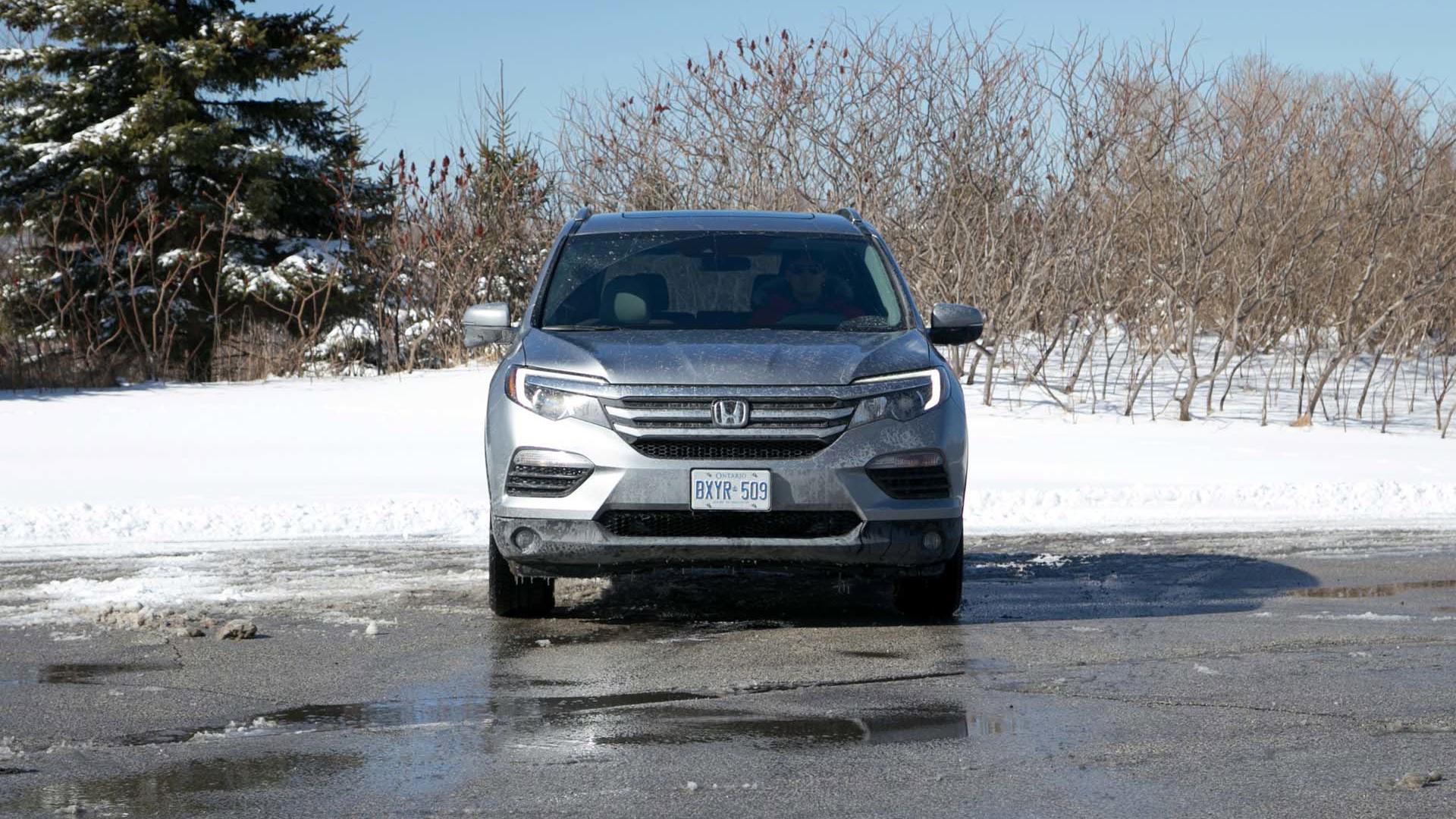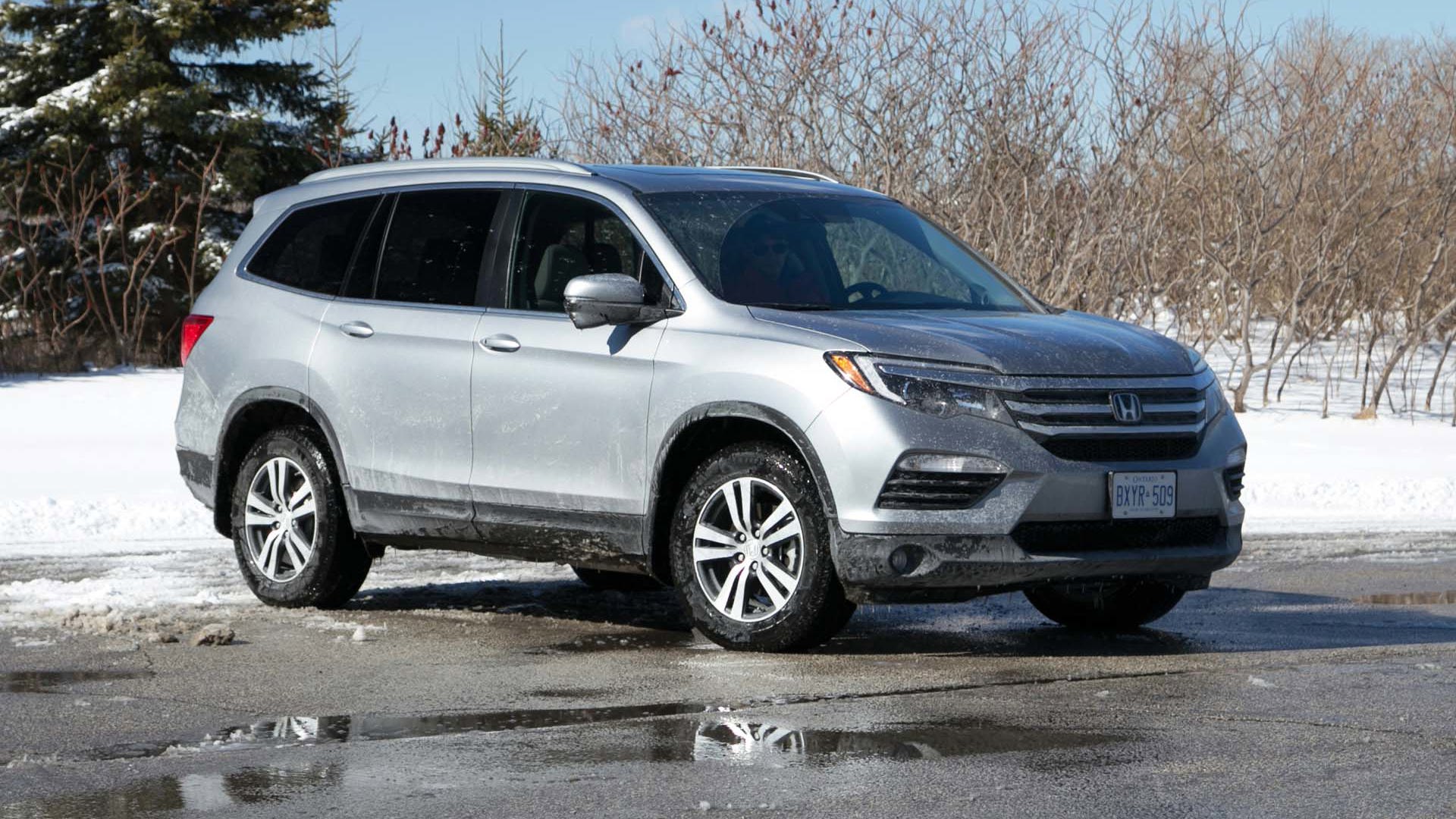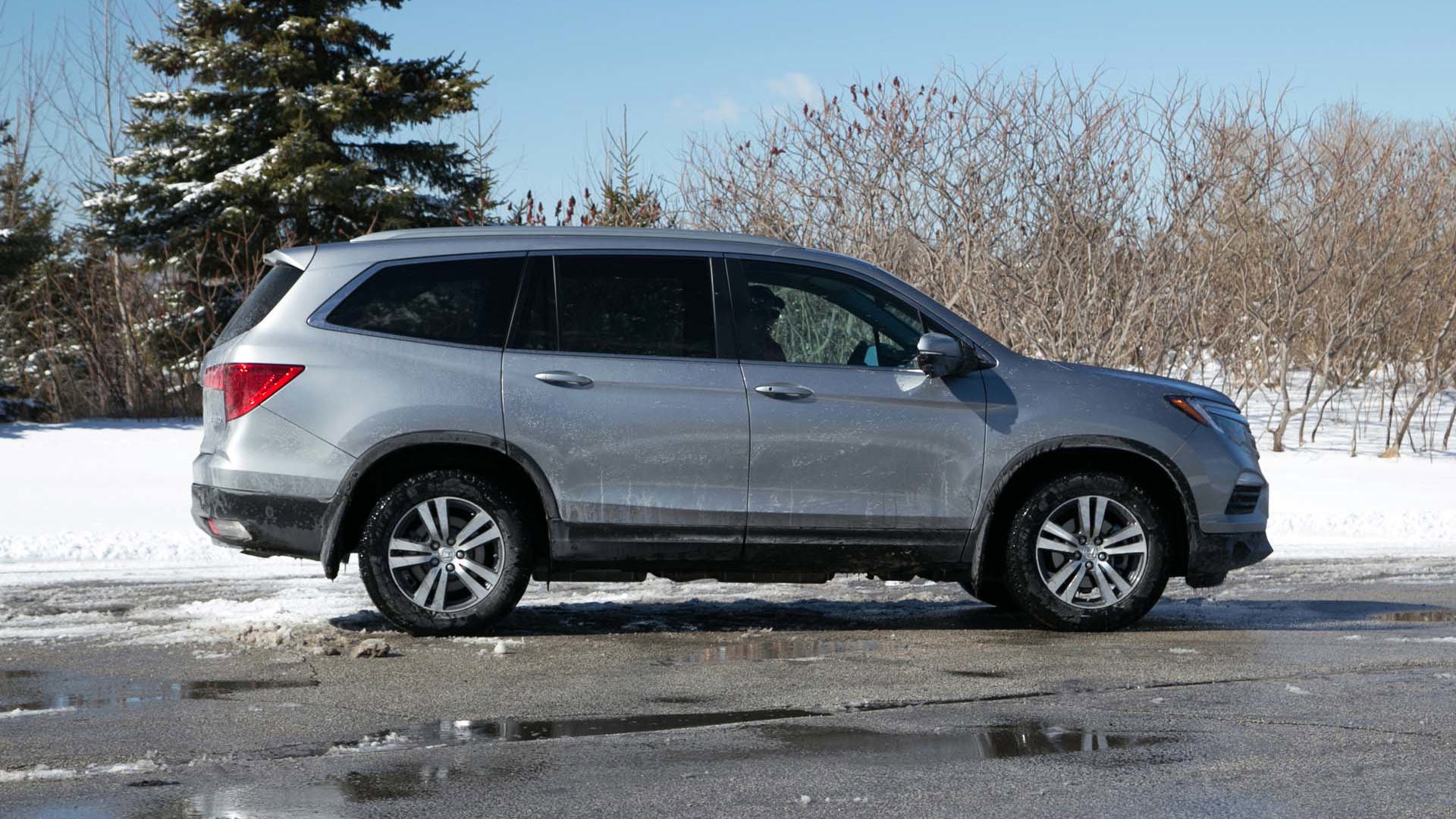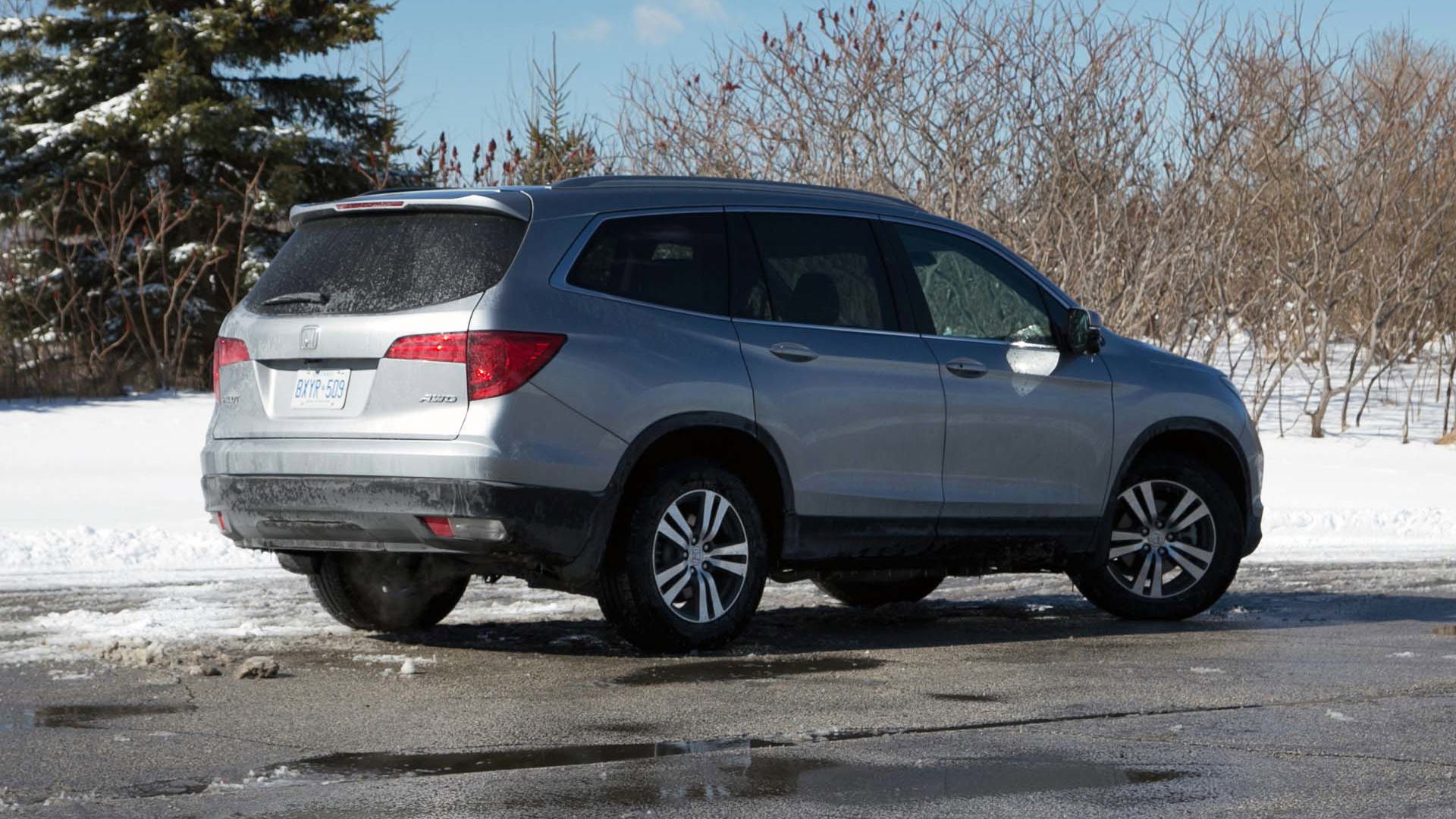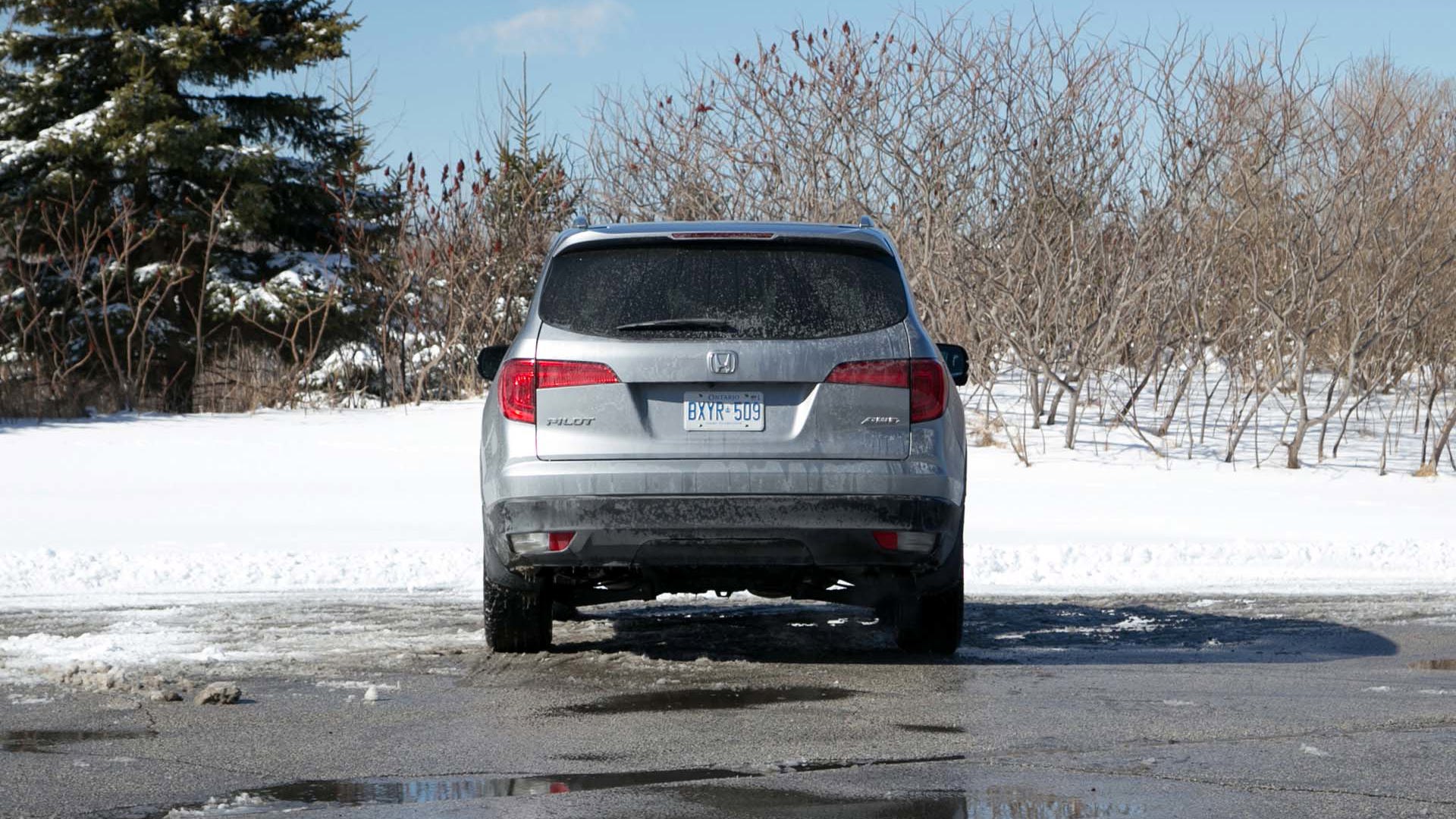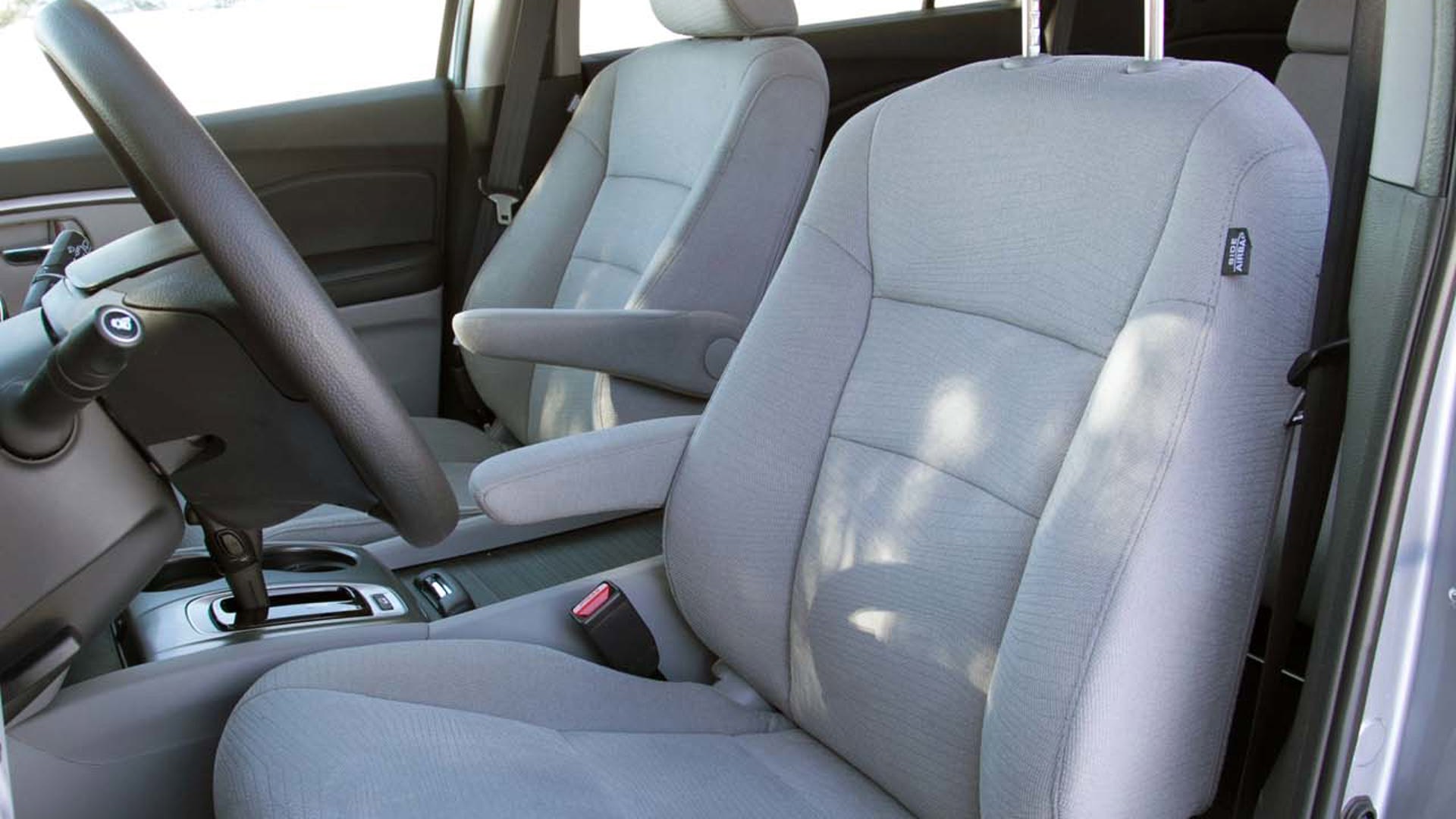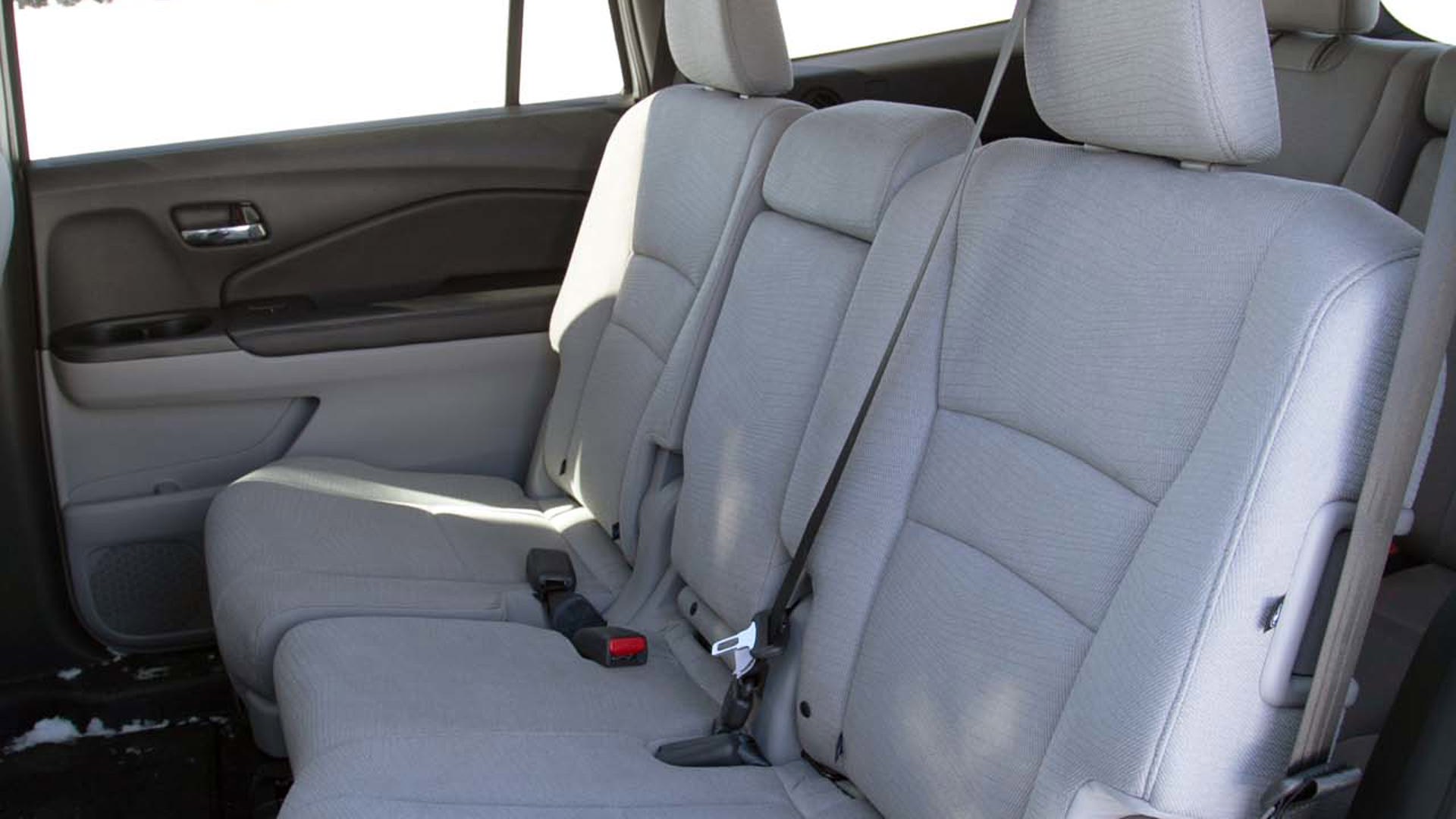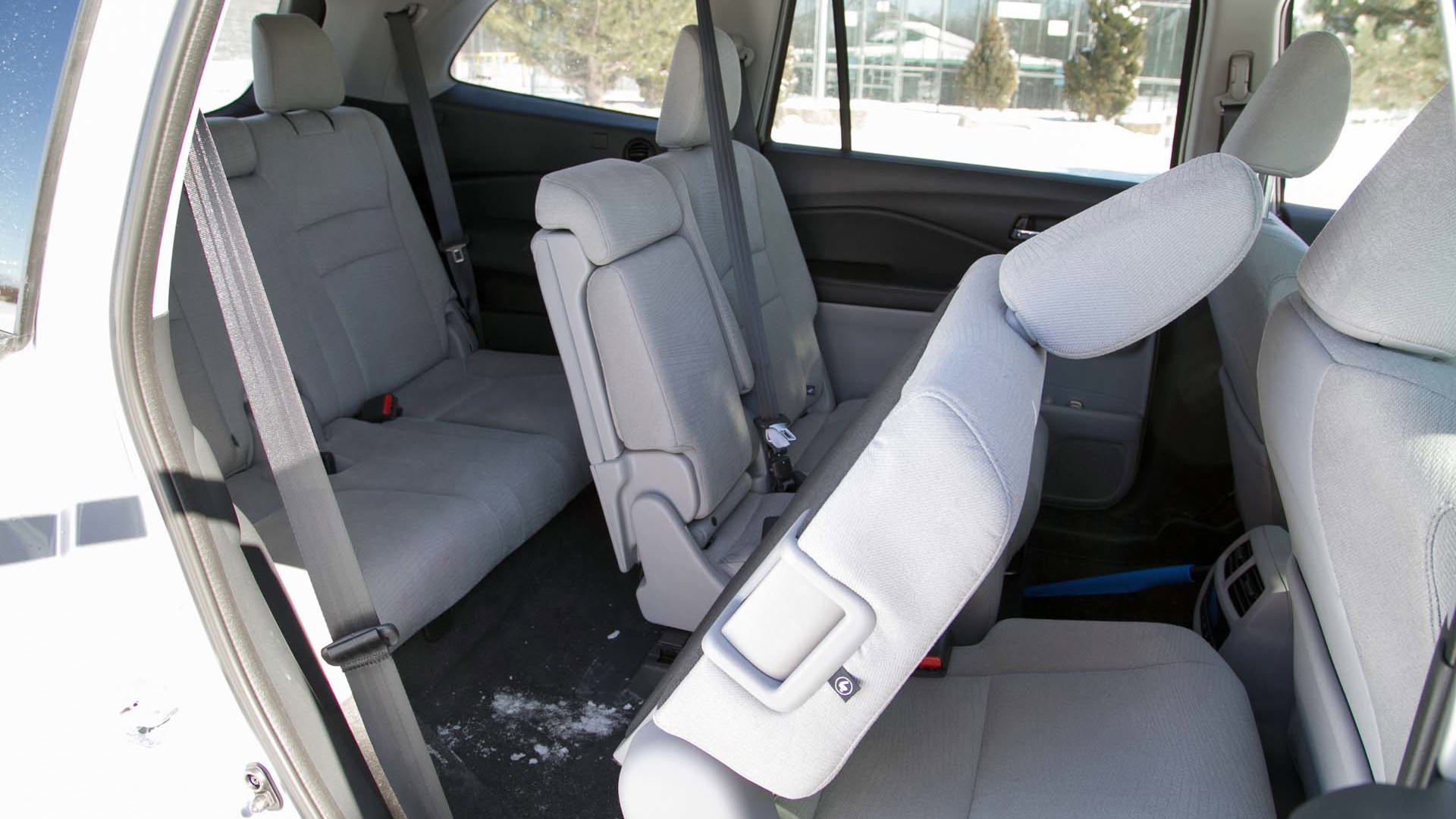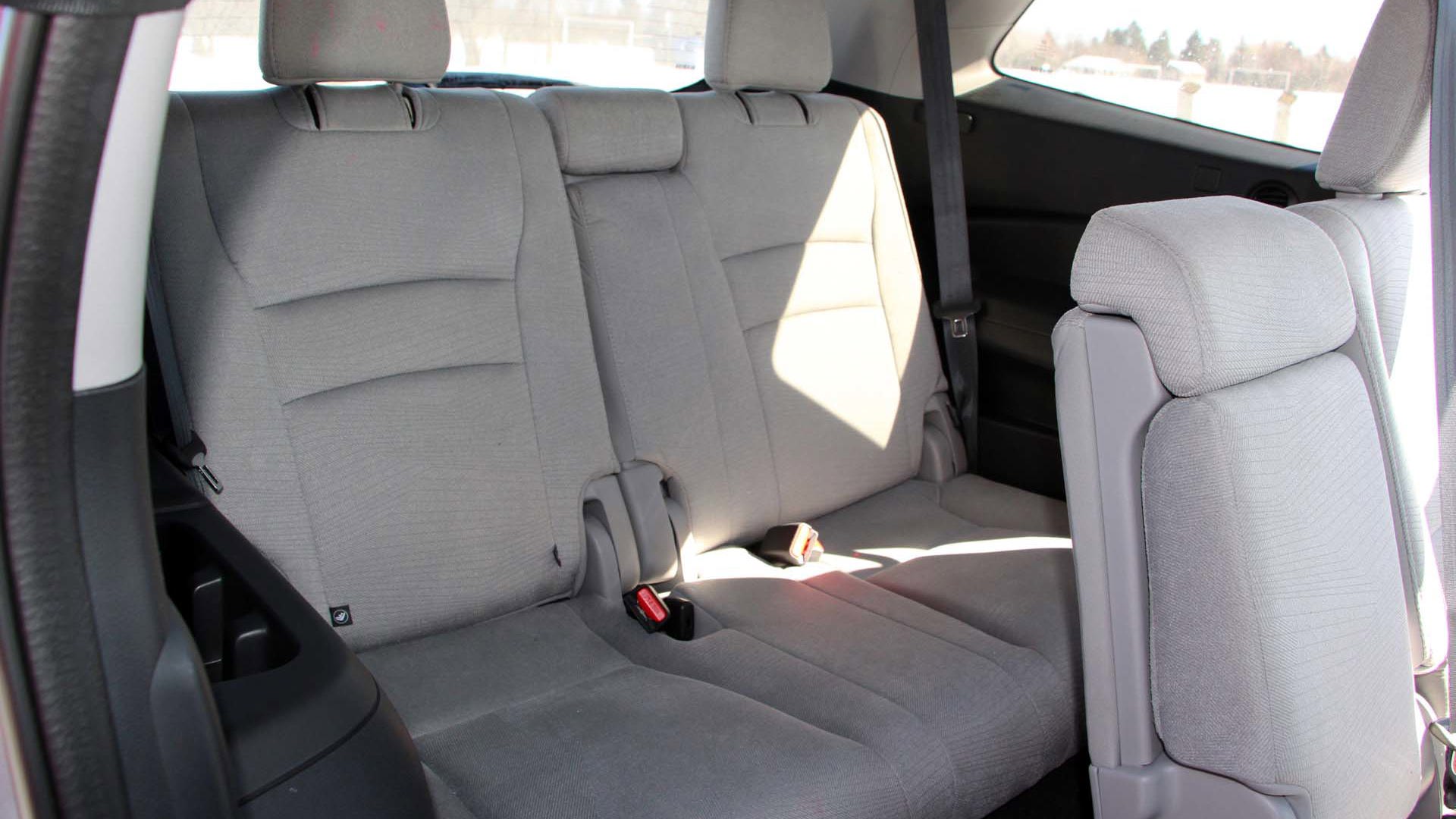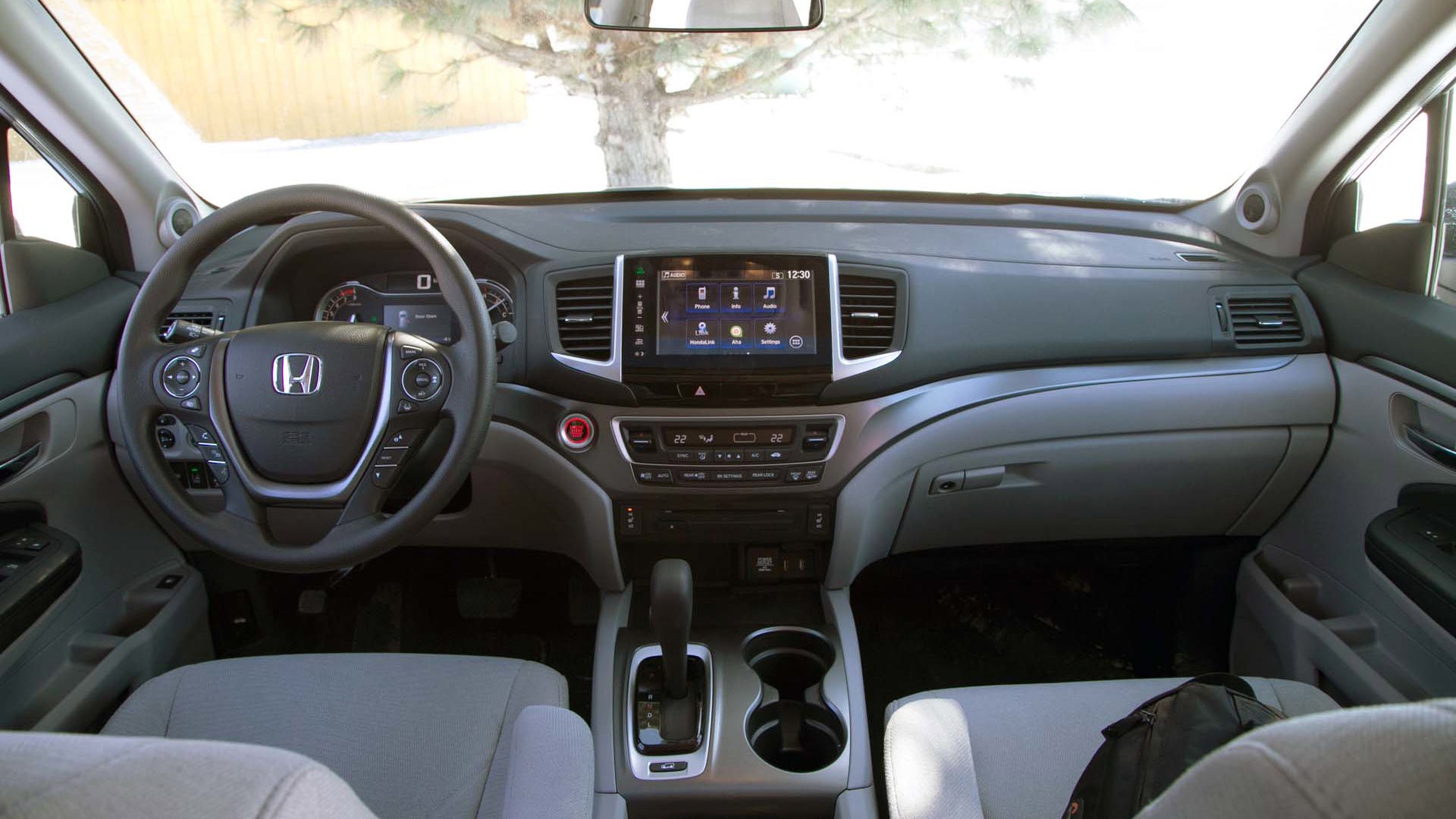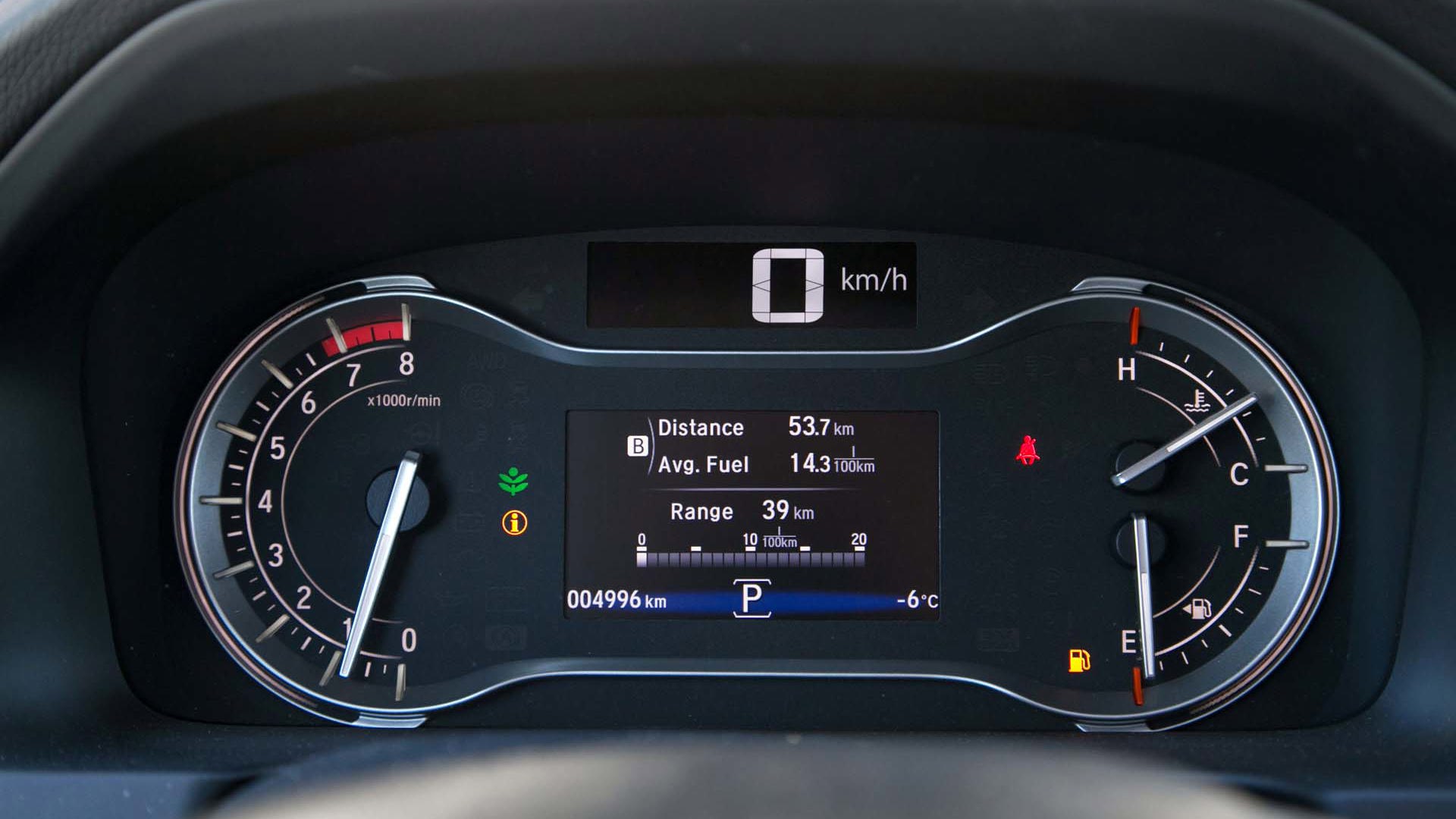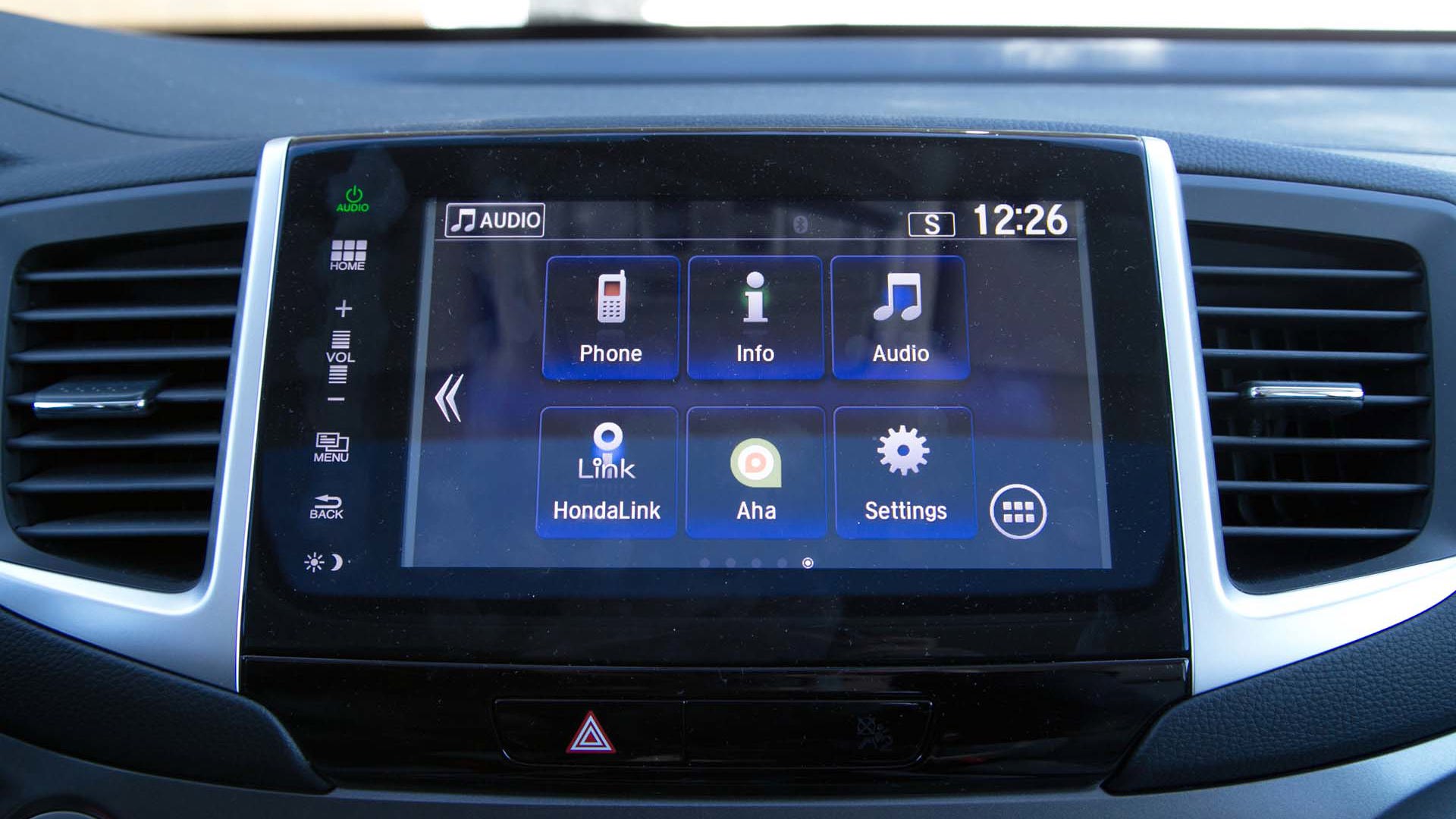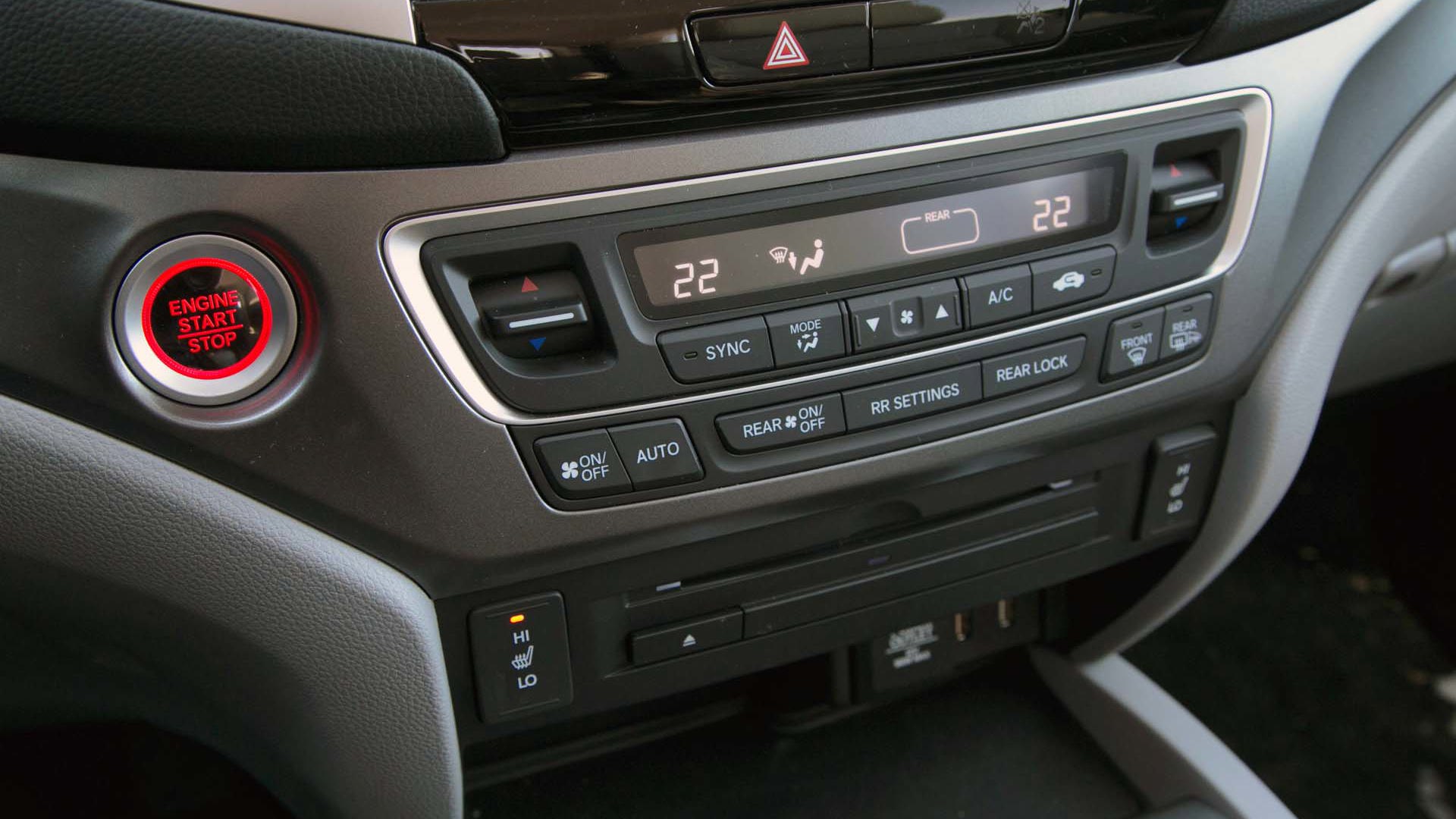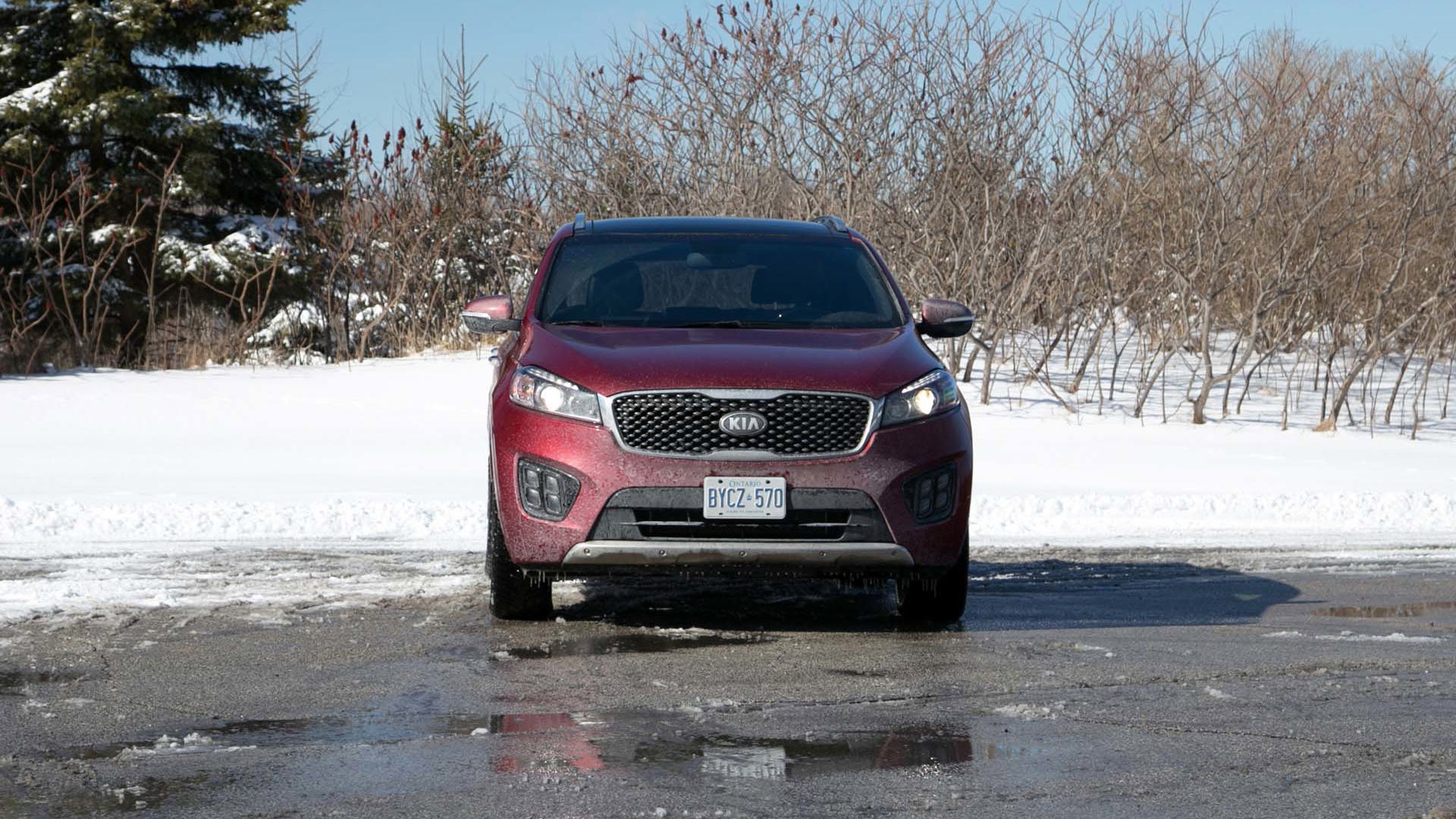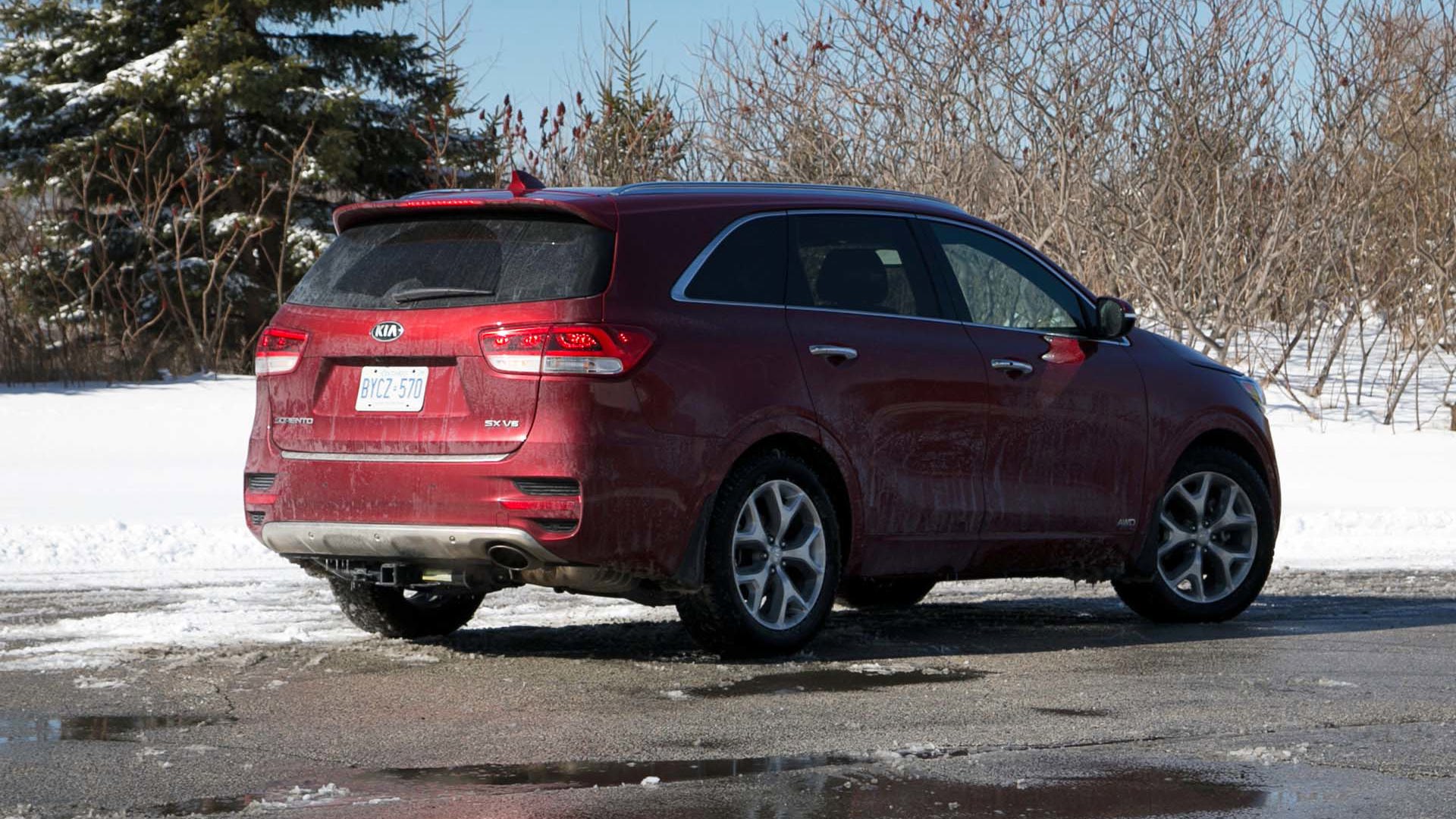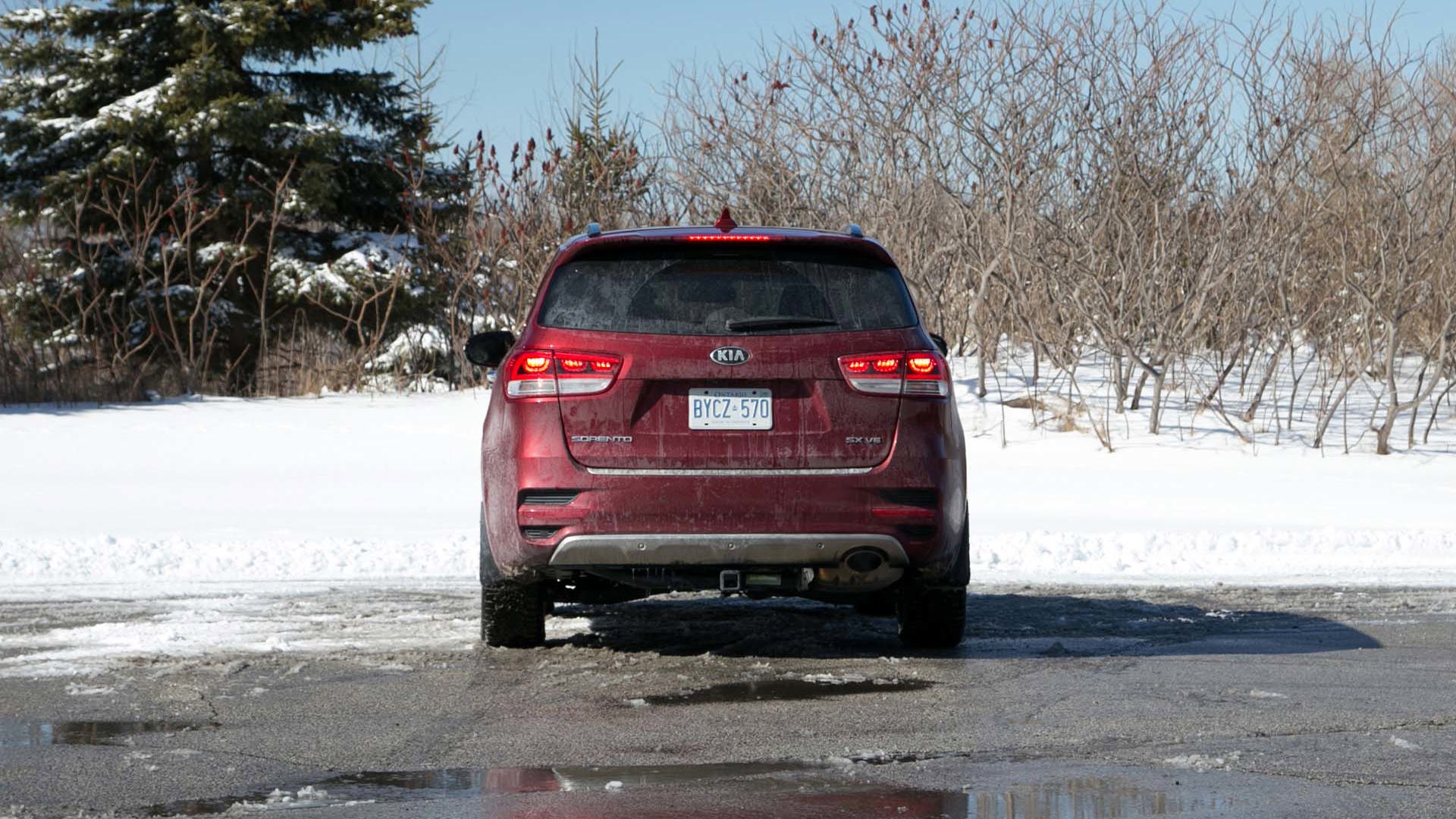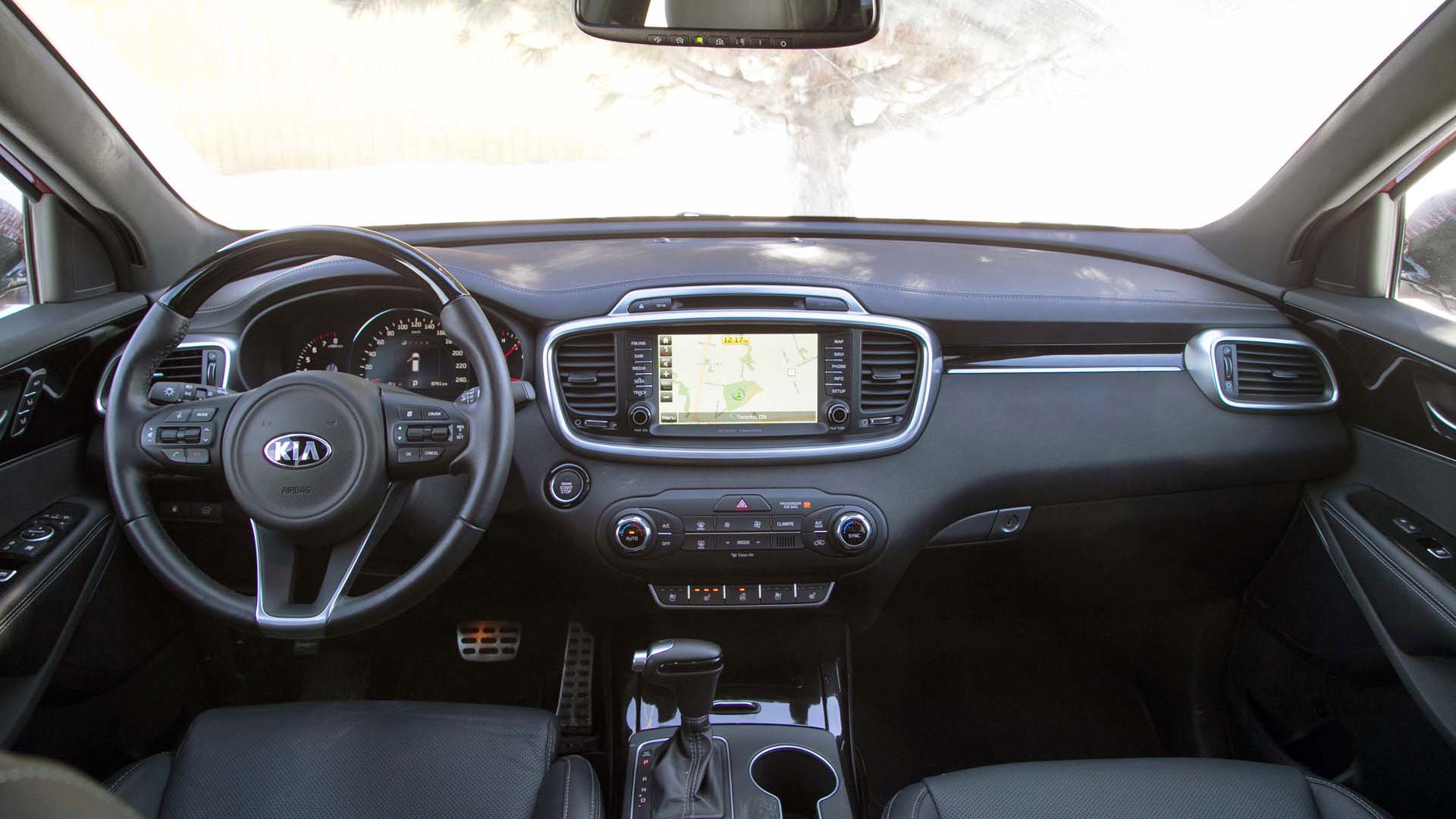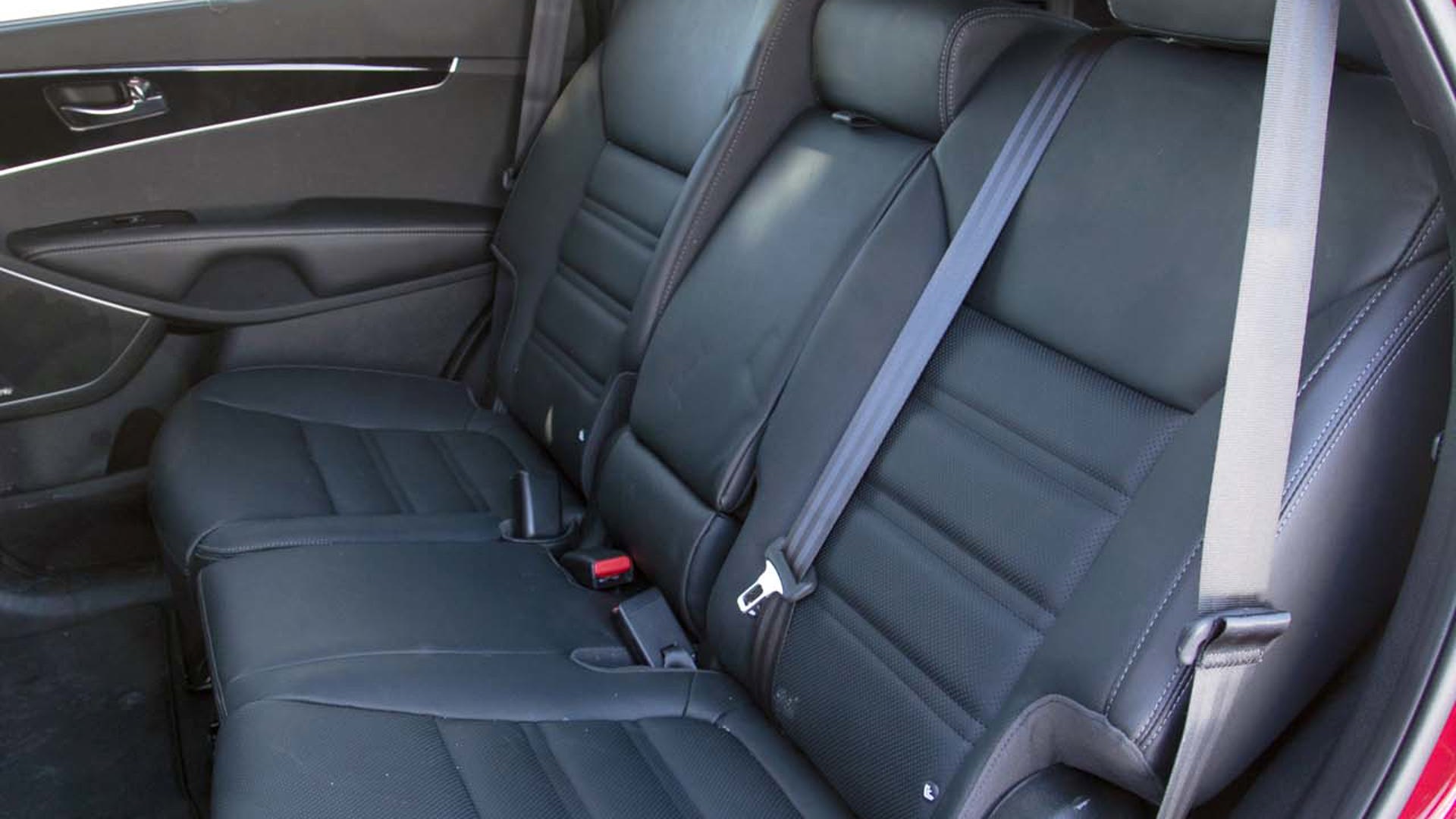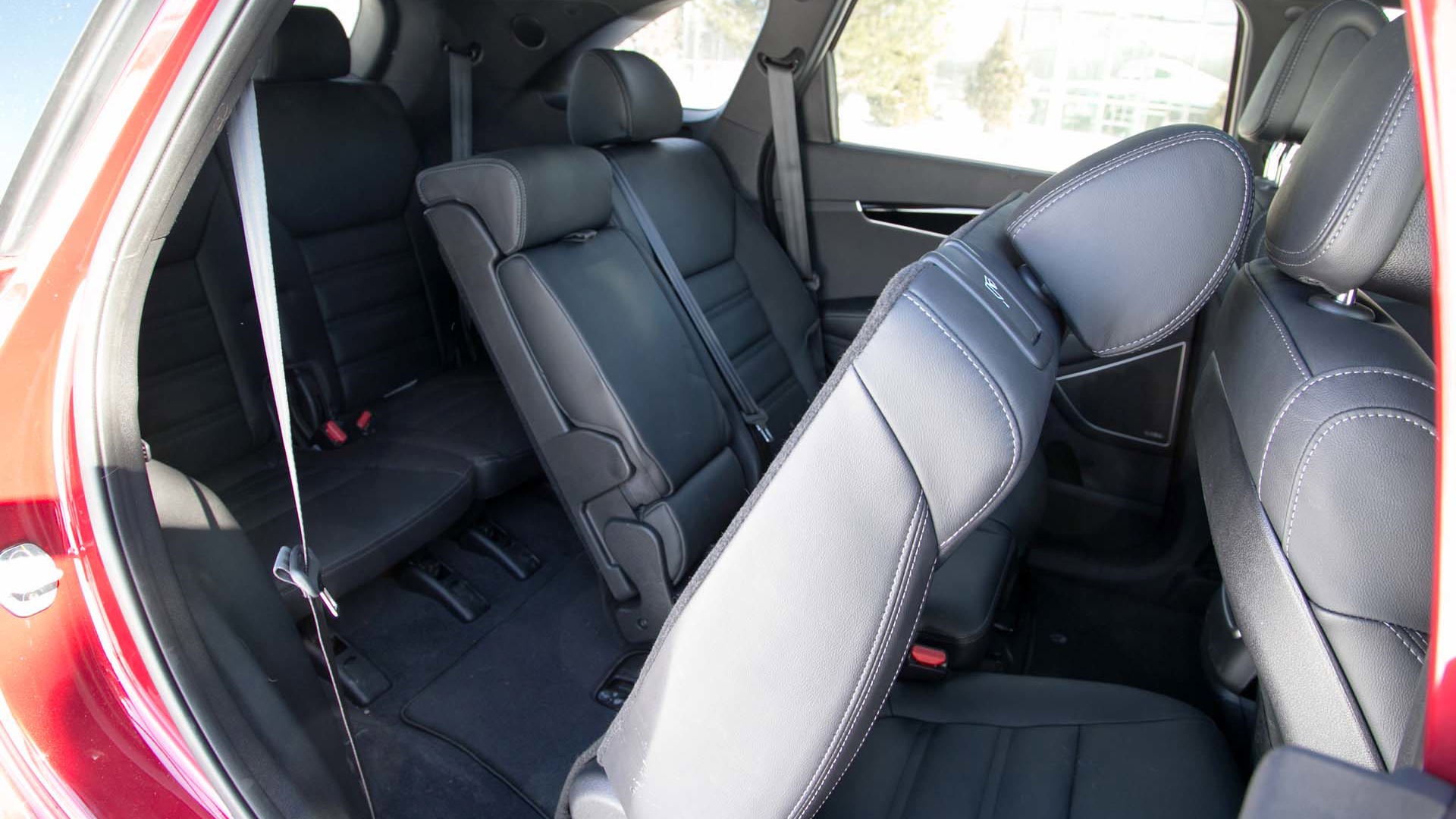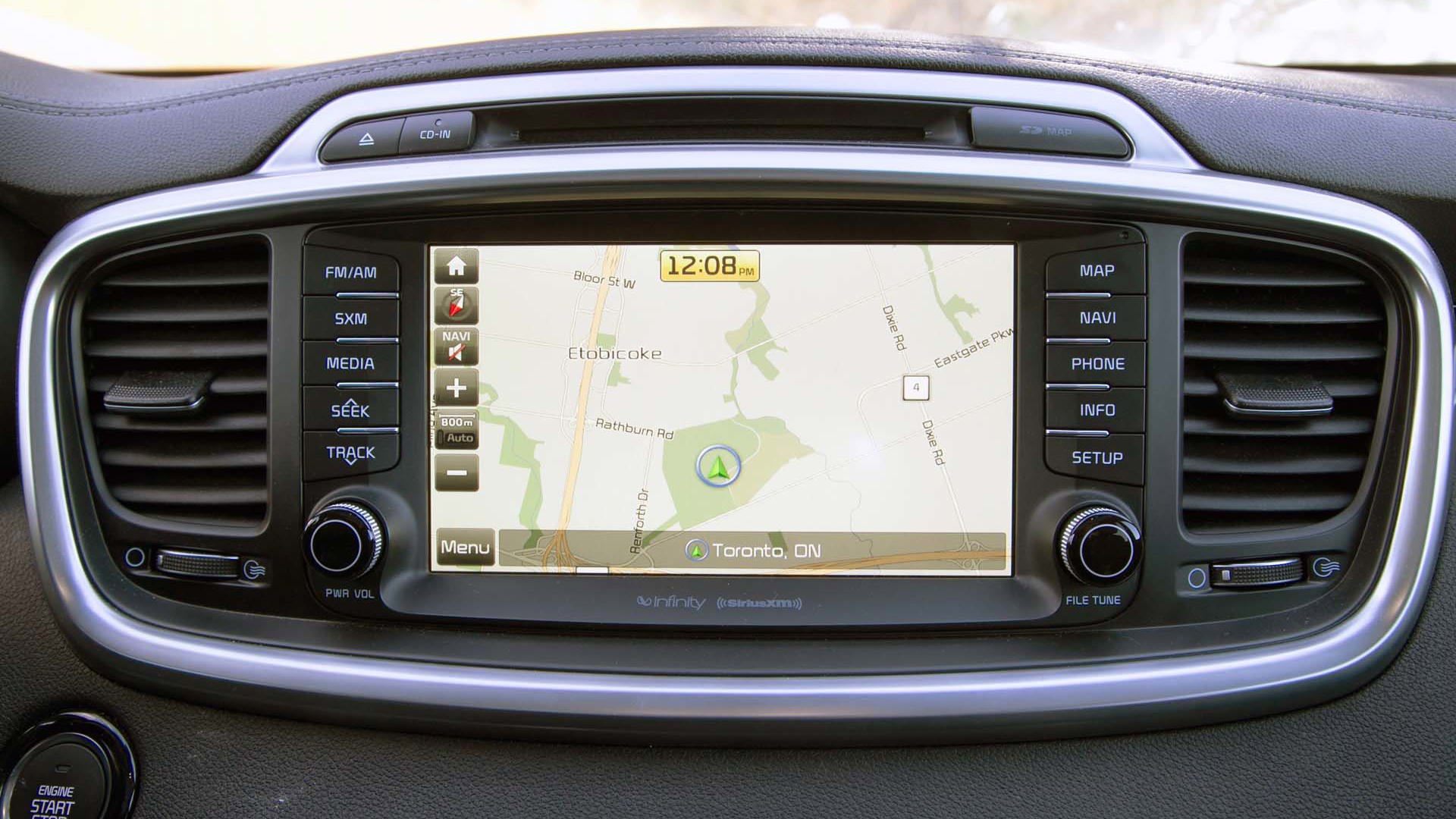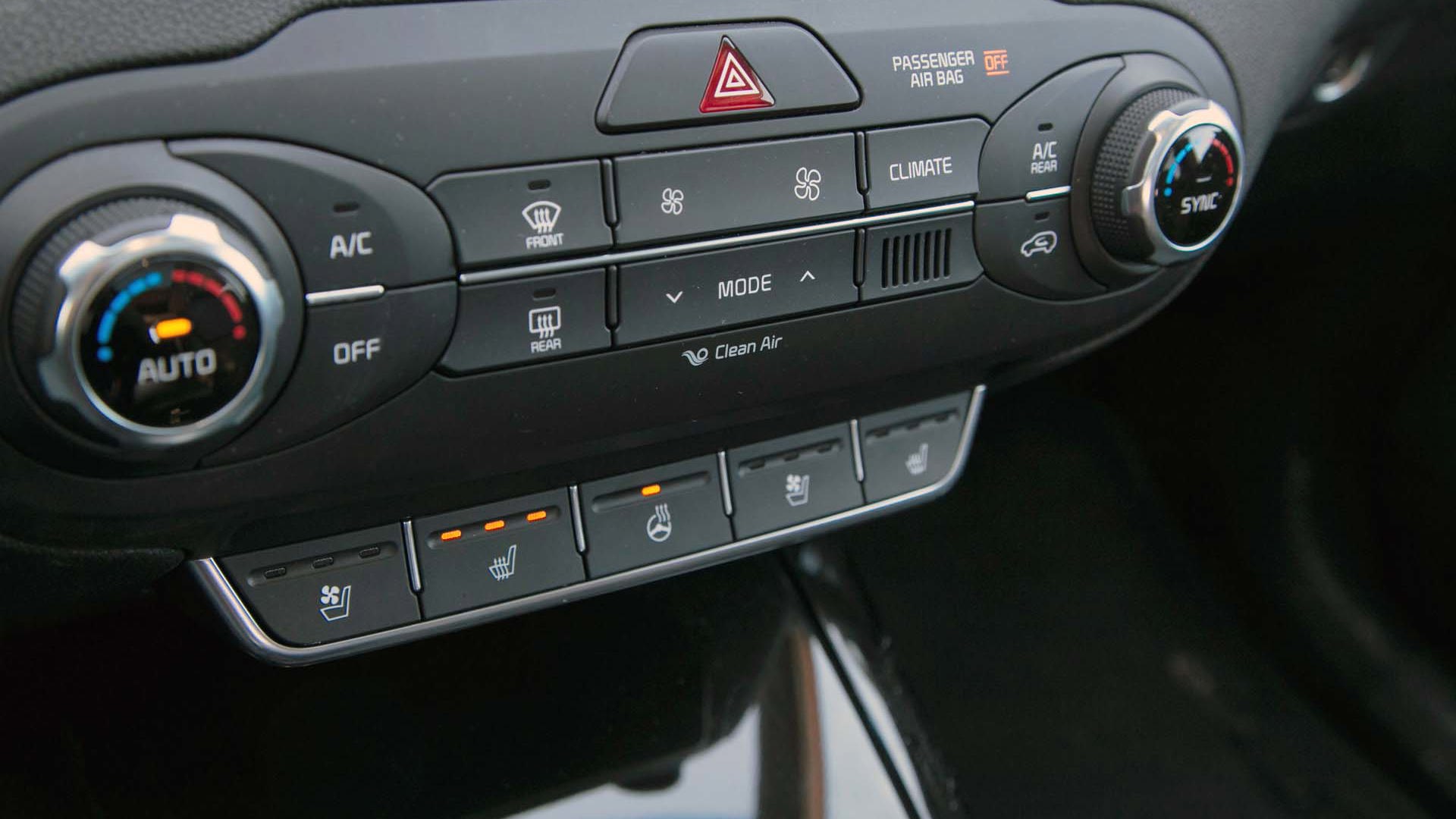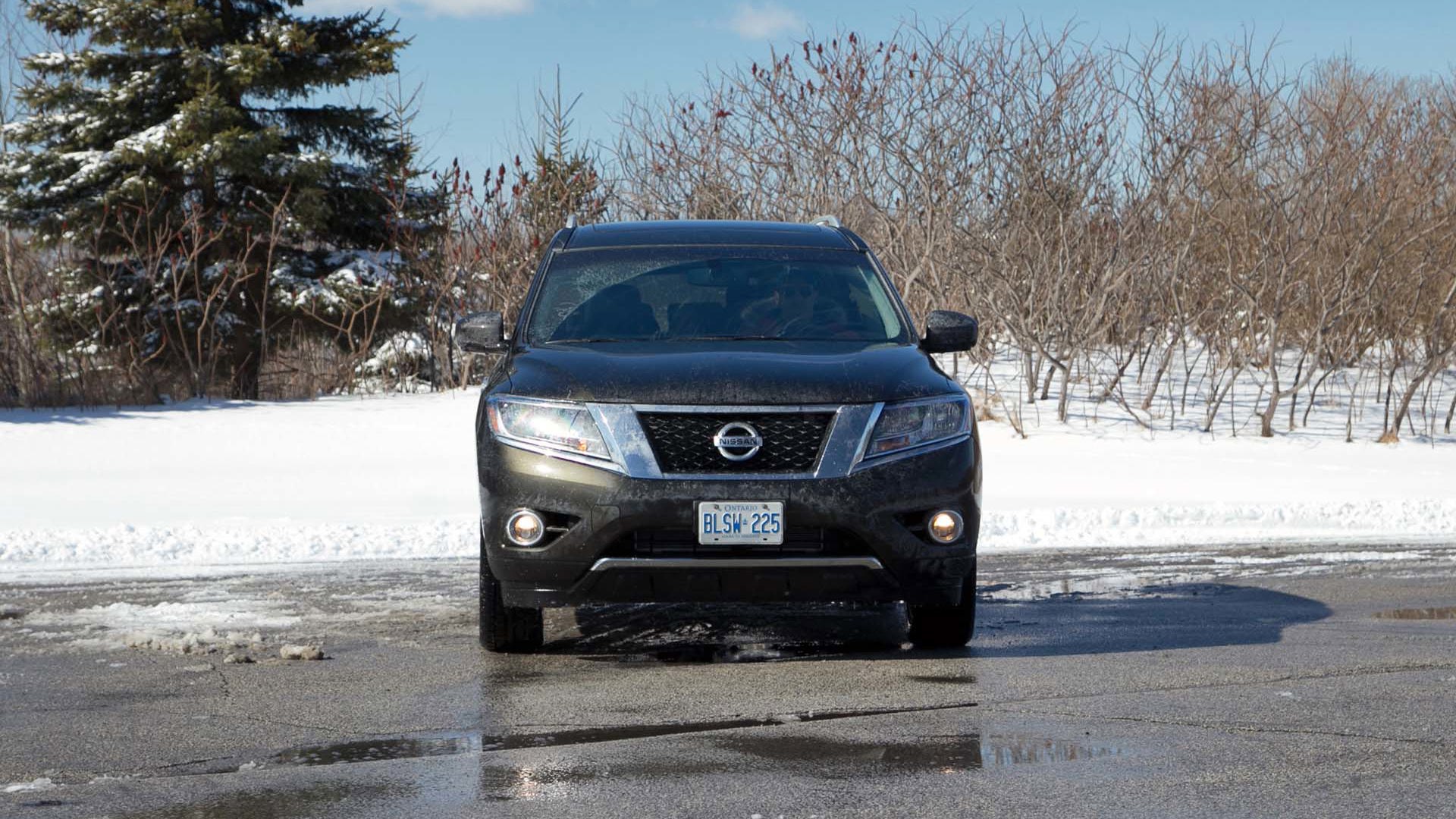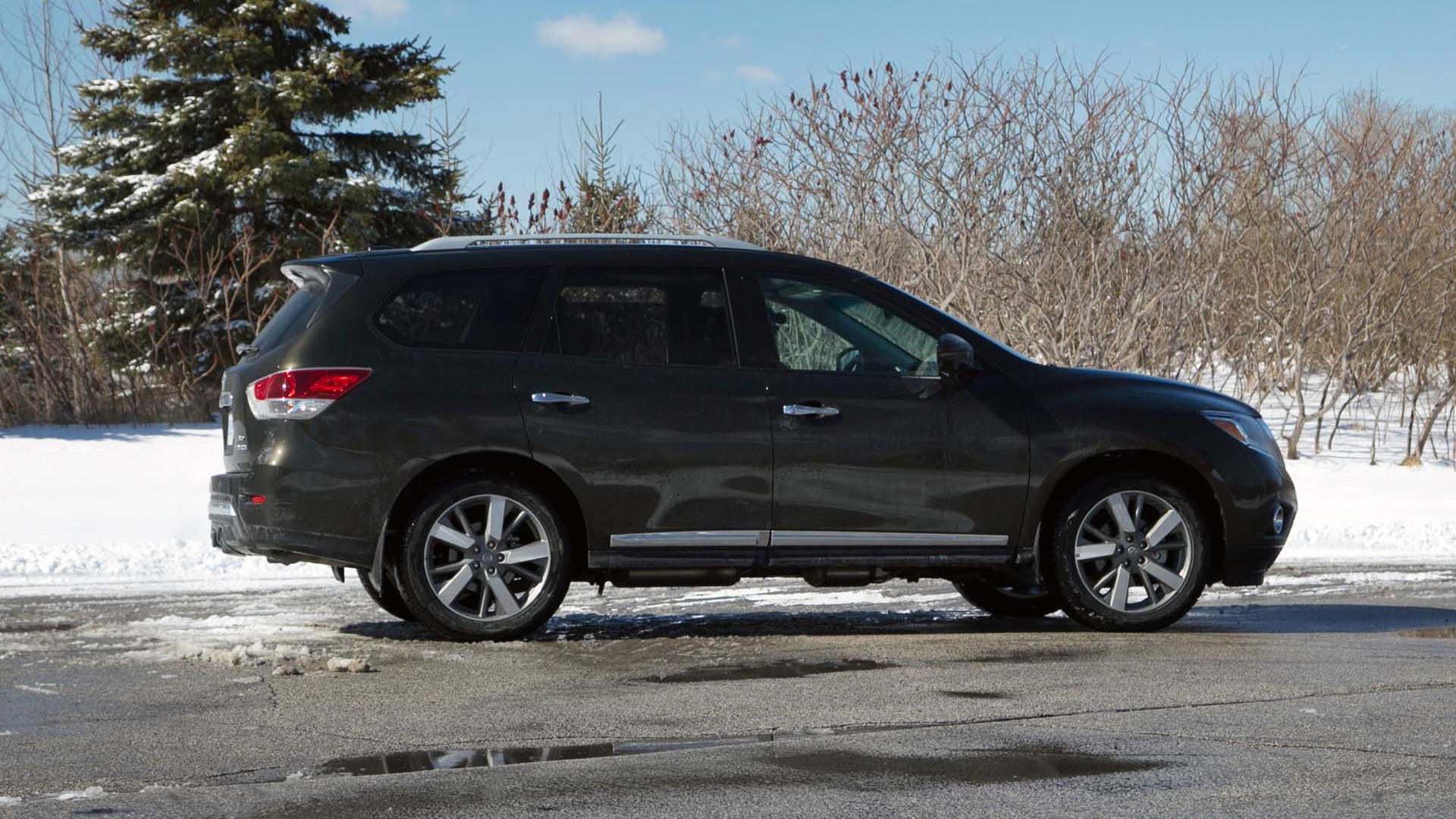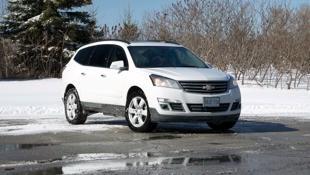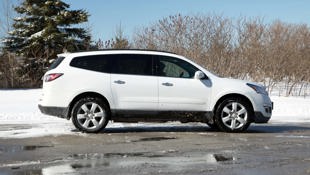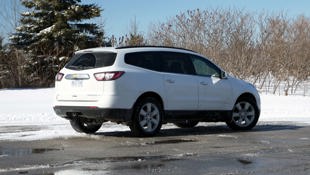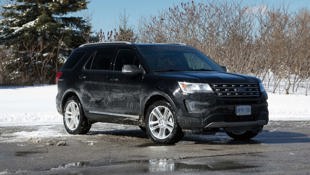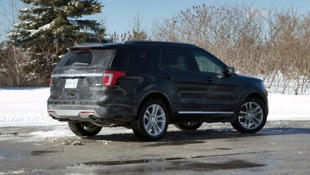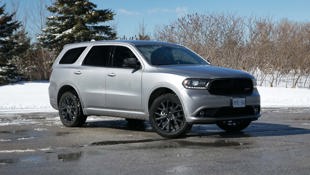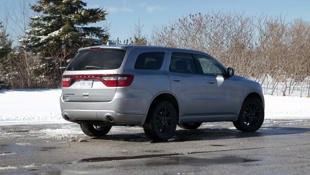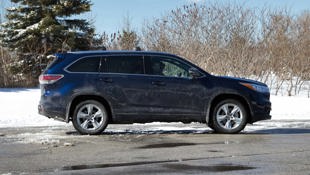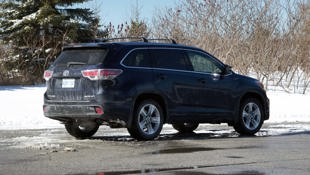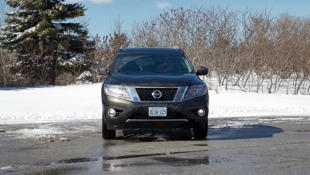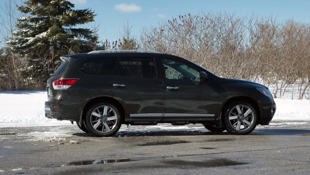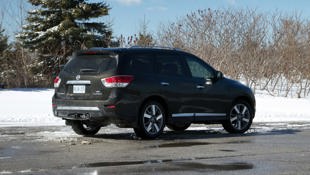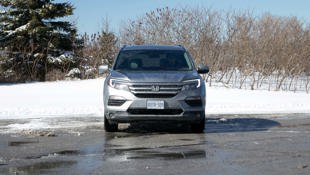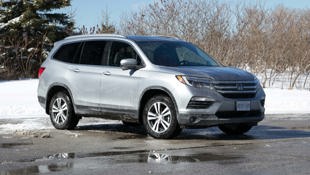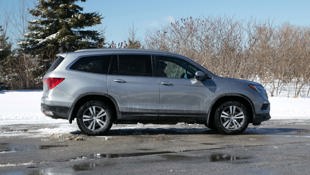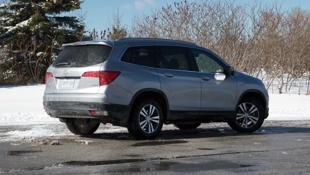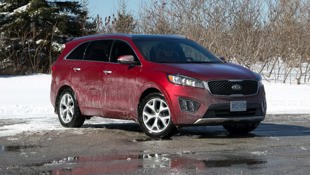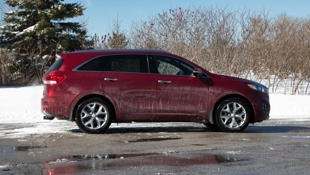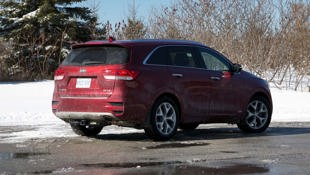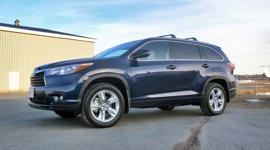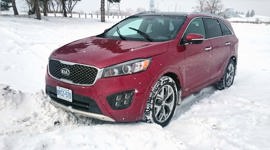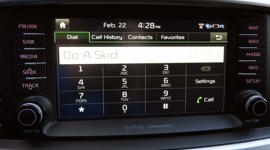Comparison Data
|
2016 Chevrolet Traverse
|
2016 Dodge Durango
|
2016 Ford Explorer
|
2016 Honda Pilot
|
2016 Kia Sorento
|
2016 Nissan Pathfinder
|
2016 Toyota Highlander
|
|---|---|---|---|---|---|---|
|
Engine Displacement
3.6L
|
3.6L
|
3.5L
|
3.5L
|
3.3L
|
3.5L
|
3.5L
|
|
Engine Cylinders
V6
|
V6
|
V6
|
V6
|
V6
|
V6
|
V6
|
|
Peak Horsepower
281 hp
|
295 hp
|
290 hp
|
280 hp
|
290 hp
|
260 hp
|
270 hp
|
|
Peak Torque
266 lb-ft
|
260 lb-ft
|
255 lb-ft
|
262 lb-ft
|
252 lb-ft
|
240 lb-ft
|
248 lb-ft
|
|
Fuel Economy
16.1 / 10.8 / 13.7 L/100 km cty/hwy/cmb
|
12.8 / 9.5 / 11.3 L/100 km cty/hwy/cmb
|
14.9 / 10.7 / 13.0 L/100 km cty/hwy/cmb
|
13.0 / 9.3 / 11.3 L/100 km cty/hwy/cmb
|
13.4 / 9.4 / 11.6 L/100 km cty/hwy/cmb
|
12.7 / 9.0 / 11.0 L/100 km cty/hwy/cmb
|
13.0 / 9.8 / 11.6 L/100 km cty/hwy/cmb
|
|
Cargo Space
691 / 3,293 L
|
490 / 2,393 L
|
595 / 2,850 L
|
524 / 3,092 L
|
320 / 2,066 L
|
453 / 2,260 L
|
391 / 2,356 L
|
|
Base Price
$40,310
|
$42,365
|
$39,999
|
$43,465
|
$43,195
|
$46,998
|
$46,980
|
|
A/C Tax
$100
|
$100
|
$100
|
$100
|
$100
|
$100
|
$100
|
|
Destination Fee
$1,800
|
$1,745
|
$1,690
|
$1,851
|
$1,715
|
$1,760
|
$1,760
|
|
Price as Tested
$46,480
|
$47,250
|
$48,039
|
$45,416
|
$45,487
|
$48,993
|
$48,840
|
|
Optional Equipment
$4,270
|
$3,040
|
$6,250
|
None
|
$477
|
$135
|
None
|
Dodge Durango vs Ford Explorer vs Toyota Highlander vs Nissan Pathfinder vs Honda Pilot vs Kia Sorento vs Chevrolet Traverse
Jonathan Yarkony
Which one best hits the mark?
Excitement. Adrenaline. Passion. Drama.
You won’t find those here in this third of our series of Crossover Comparisons in the past year.
We started with the sales-chart dominating compact class, which has taken over as Canadians’ favourite go-to everyman’s car over the humble compact sedan. Then we tackled the growing subcompact crossover class, which try to offer similar utility in an urban-friendly and economical size. Now it’s time for the middleweights: mid-size, three-row crossovers with seating for six or seven and everything a family on the go to replace their faithful but stigmatized minivan.
While there’s nothing wrong with a minivan in our eyes, crossovers are where the money is, so companies spare nothing to put a strong product forward and capture the attention of moms, dads, grandparents and people with lots of friends. And it shows, with crossovers offering increasingly improved driving dynamics, surprising efficiency and clever packaging along with a hint of that rugged all-weather mastery that incited the SUV craze in the first place.
But which one best hits the mark? We collected as many as we could to see for ourselves what brand delivers the best family shuttling experience and what unique strengths (and weaknesses) each of these vehicles demonstrates.
Each of these mommy/daddy buses lands at under $50,000, even after destination charges, with only several thousand separating our most affordable to the priciest. However, we recognize that many times it is the monthly or bi-weekly payment that is the true bottom line shoppers look at, so we’ll provide a quote on current deals we were able to score online in case that influences the appeal of any given model.
Our comparison centred around our long-term 2016 Kia Sorento, which has impressed us at every step of the way, and was robbed at AJAC’s testfest, losing out on the Utility Vehicle of the Year hardware to the fun-but-not-very-practical-for-more-than-a-few-shoeboxes Mazda CX-3 (our previous long-term tester – We sure know how to pick winners here at autoTRADER.ca). The Kia offers a balance of feature-laden value at $45,487, but has its driving and interior come far enough along to eclipse favourites from Toyota and Honda?
Honda had the freshest crossover of the bunch, the Pilot freshly redesigned for 2016 with sleeker looks and a modern yet typically practical Honda interior. But would its human machine interface survive the day (and Jacob’s wrath)? It was notably the cheapest in our test, its $43,465 EX model offering a great value proposition for a familiar and trusted utility.
The Toyota Highlander has impressed us ever since its 2014 redesign, which, although fairly ordinary on the surface, delivered a sturdy, steady vehicle with an impressive interior that seemed to offer just the right mix of practicality and comfort to earn it the nod in a head-to-head matchup with the Hyundai Santa Fe XL, the winner of our previous big comparison of three-row utes. Our Highlander was the Limited AWD that landed at $48,805, but would it have enough appealing features to justify its price?
Sadly, the Santa Fe XL was unavailable to defend its crown, arriving a mere few weeks too late to participate despite a refresh and early launch of the 2017 model. Mazda’s new CX-9 is another strong contender due to arrive this summer, but was unavailable for our test.
We were also very pleased to welcome SUV from each of the Big Three, Chevrolet’s Traverse (a $46,380 1LT AWD), which is admittedly in the twilight of its generation, the recently refreshed Ford Explorer ($48,039 in XLT AWD trim with the 3.5L V6), and Dodge’s Durango looking badass in its Blacktop Package ($47,280 for the SXT AWD with the V6 Pentastar).
Finally, if there was a dark horse in this race, it was Nissan’s Pathfinder, which only lost out in our last comparison because we had the limp hybrid rather than the stellar V6 that turned up this time. The Pathfinder was a fully loaded Platinum model with a full array of driver aids and luxuries at $48,893 (the priciest of the bunch, if you’re keeping track).
Mother Nature blessed us with a fresh layer of snow for our photos, so we also got to see the AWD in action, and despite some of them being shod in all-season rubber, none of them missed a beat on the warm and sunny driving day. In the end, we found that each of the vehicles in our test would be a trusty family chariot, some catering to outright cargo practicality or flexibility, while some would pose a fair substitute for luxury vehicles of recent vintage, while the winner, of course, did a little bit of everything well.
7th Place: 2016 Chevrolet Traverse, Jonathan Yarkony
First of all, let’s show some appreciation for GM here, in that they were willing and eager to put forth their aging mid-size SUV after the Acadia got a little bit clobbered last time around. Despite the age of this platform, and the new mid-size SUVs due to arrive imminently, starting with the 2017 GMC Acadia, GM is confident in the Traverse, and we think it is a genuinely useful and appealing vehicle at this price point (well, maybe with a few incentives…).
Let’s start with its strong points, its overall cargo capacity being judged best in our group, tied with the Explorer, and reasonable flexibility and ease of use converting to cargo mode. Lo and behold, our eyes did not deceive us, with 691 L of trunk space behind the third row and up to 3,293 L of hauling space if need be. However, it comes at the expense of passenger space, with second row seats scoring poorly while the third row was average, and even the driver’s seat was judged as one of the least comfortable, behind only the awkward Explorer.
Also earning top marks was GM’s warranty, notably the 5 years and 160,000 km for which the powertrain is covered, even if Kia’s 5 year, 100,000 km has the edge in total vehicle coverage.
And that’s about all the good news for the Traverse.
While the scoresheet makes it look worse than it is, and it is still a fair choice for many consumers and one I would endorse at the right price, there is much that the upcoming replacement can definitely improve upon.
Its 3.6L V6’s 281 hp and 266 lb-ft are respectable, but carrying around 2,248 kg ain’t easy, not surprising given that it is longer and wider than any other rig in this test. Saddled with so much weight means the V6 must work hard, and it doesn’t necessarily sound good getting the job done, with a transmission that frequently got caught out between second and third gear. At the end of the day, the Traverse also rang up the highest fuel bill, chugging back gas at a rate of 15.3 L/100 km on test day, well above the EPA’s combined estimate of 12.4 L/100 km, which was also highest in this group.
Noah summed up the driving experience for most of us: “While the engine was nice enough, the transmission was sloppy and slipping gears. Handling was better than expected, but add on the worrisome brake feel and I just didn't trust it. I was just unhappy to be in that car. I really couldn't wait to get out of it.” While it’s a fairly simple vehicle and no great challenge to drive, poor sightlines and its large size made it one of the harder cars to park and maneuver in tight quarters, though a back-up camera and parking sensors make it a manageable affair.
However, the greatest weakness in the Traverse is an interior that has fallen well behind the times. The Lambda platform has served GM heroically, accounting for over 2 million sales in over 10 years on the market, and despite updates to equipment, the interior finish just hasn’t kept up, and we noted obvious fit and finish issues, with further complaints about “Some pretty awful panel gaps, weak gauges and small, dated touchscreen.” And at $46,380, the feature list did little to impress (landing at the back of the pack for Feature Content), even with its exclusive onboard wifi, which many consumers would not want to pay an extra monthly subscription for on top of their cell phone bill.
This GM mid-size SUV platform has been a great fit for Buick, GMC, Chevrolet (and even Saturn) over its many years of service, but despite recent updates, the interior quality is showing its age, and even novel tech like onboard wifi and available driver assistance systems isn’t enough to overcome its thirst, lack of refinement and underwhelming driving qualities. On the plus side, it is the most spacious for cargo, with a standout warranty, so if you’re looking for a practical and spacious people hauler, look for Chevy dealers to be discounting and incentivizing these utilitarian rigs in the coming year.
6th Place: 2016 Ford Explorer, Lesley Wimbush
It wasn't that long ago that the Explorer's style would've earned it top marks in its segment. But the crossover market is currently so hot that competition – and customer expectations – are right off the charts. It's no longer enough to be versatile, reliable and efficient, you've also got to look good while doing it.
The Explorer is indeed a handsome vehicle, but then so are most of its competitors. We liked the crispness of its exterior, but not as much as the Kia Sorento's, which took the top spot for its sculpted lines.
Its interior styling didn't impress most of our judges though. Most of the criticism was directed at the extensive use of dark materials, which gave the cabin a rather gloomy atmosphere. The abundance of hard plastics and "cheap feel of the knobs" were also mentioned.
Surprisingly, given its decidedly non-boxy looks, the Explorer had the biggest cargo space with a positively voluminous minivan-style well behind the third row. What's more, it had the lowest trunk floor, and therefore the best "lift over" in the group.
We all agreed that the Explorer's handling was first-rate, with a stiff suspension that made it very stable on the off-ramps, but a bit harsh over rough pavement. Steering and braking was excellent and second only to the Sorento.
But the Explorer came up short in some key areas, particularly when it came to comfort and refinement.
Only the Chevrolet Traverse scored lower for noise, vibration and harshness. Granted, it was a sloppy day, wind and road noise were noted frequently, and one judge mentioned hearing rocks and water against the underside and fender wells.
While it impressed with trunk space, the Explorer fell down in seating and cargo flexibility. We loved the Durango's quick tug and tumble second row seats, and the Pilot's tucked away easily with one hand. By comparison, clambering into the Explorer's hard, flat rear bench was best left to the young and limber.
When it came to child seat installation – a simple thing, yet capable of reducing a frazzled parent to a quivering pile of raw, sobbing nerves – the Explorer came in dead last.
While some of the taller drivers complained about the short seat bottoms, I found the driver's seat quite comfortable. The pedal placement however, was so close together with and skimpy and crooked dead pedal that clunky winter boots could easily overlap the pedals. Senior Nitpicker Yarkony wouldn’t let it rest: “But that dead pedal was supremely annoying, with some framework interfering with keeping one’s left leg straight, and the space for your foot awkwardly angle that would drive me bonkers if I ever had to drive it for more than an hour at a time, given that the seat itself had an uncomfortable bottom.” The myriad small buttons and knobs were likewise difficult to use with gloves or mitts, though MyFord Touch was quick and easy to navigate on the whole.
Fuel economy is an important consideration in most segments and particularly so for family vehicles. With an observed fuel economy of 15.1 L/100 km overall, the Explorer was second last – with only the Chevrolet Traverse's 15.3 being worse.
As tested, the $48,039 Explorer was the third most expensive of the group, but ranked second last for perceived value. This doesn't mean it's a bad vehicle. But if your main criteria when looking for a new vehicle include flexibility, space and comfort, there are other vehicles that might better suit you and your family.
5th Place: 2016 Dodge Durango, Jeff Wilson
Look, in a group of softy utes ideally suited for soccer dads, the Durango is the one rig that seems to suit the parents whose kids play rugby or participate in mixed martial arts. There’s something a little more tough and macho about Dodge’s Durango that’s absent from the other SUVs in this test. This thing feels like it almost earns being called a truck.
Of course a lot of the Dodge’s machismo comes from its rugged looks, set off by the big, black wheels and “racetrack” lighting across the rear. The big Ram-style grille up front doesn’t hurt either. But it’s also the size of the Durango that helped generate a lot of favour amongst our evaluators. Dimensionally, the Dodge is second only to the portly Traverse for length and width, but stands taller than all of ‘em, making it a more imposing machine.
While that elevated height worked against the Durango for ingress and egress, the ground clearance will surely be appreciated by those who actually need to get through some deep snow en route to the cottage.
Still, despite its bulk the Durango placed only mid-pack for its second and third row seating comfort, and near the bottom for usable cargo space. A bright spot for the Durango is the considerable ease of access to the third row, thanks to a spring-loaded second row seat.
Once inside, this particular Durango was a little skimpy on the features and amenities, sporting a tiny screen that doesn’t do justice to the Uconnect we’ve grown to love in FCA’s contemporary offerings. No active safety features, no cooled seats and no sunroof were found in the Dodge. The front seats – finished in a sporty Alcantara – were derided by a few of our group who found them uncomfortable and flat. But they sure do look good after stepping out of the bleak, grey Pilot.
The driver faces a comprehensive set of gauges and graphics, and mostly logical controls operated via large, simple knobs, while the hidden buttons on the back of the steering wheel spokes offer intuitive controls for audio functions.
But it’s the Durango’s Pentastar V6 engine that generated praise from the hooligans in our midst. It’s got decent power, a gruff soundtrack and gearing that helped some of us take good advantage of the snowy parking lot we used as our home base for the drive day. And while the console-mounted gear knob seems cool, it takes an adjustment period to get used to that.
While the Durango can be big fun in wide open spaces, it is severely challenges in tight quarters. Noah observed: “It drives huge, bordering on tank-like. While that made for quite a bit of fun in the parking lot, it was a lot to handle in terms of daily tasks as outward visibility was sickeningly bad (measure those A-pillars - they're HUGE).” Another drawback of its size was its thirst, 14.7 L/100 km on test day despite an appealing 11.2 L/100 km estimate by the EPA for combined driving.
Head hooligan, Jacob Black summed up his experience with the Durango by claiming, “It’s not the SUV you need, but very much the one you want.” As the most fun and raucous rig in our group, he’s not wrong. But if that’s what you’re after, you should probably know the Durango R/T with a beastly Hemi V8 can be had for less than $50,000.
4th Place: 2016 Toyota Highlander, Peter Bleakney
There’s a reason why Toyota sells a gazillion vehicles, and a few moments behind the wheel of this Highlander seven-seat crossover tells the story. It had the second highest raw score of the bunch and topped out in the Cargo Space, Practicality/Flexibilty (passenger/cargo) and Ride Comfort categories. Additionally, the Highlander scored second highest in NVH (noise, vibration, harshness), Cabin Storage, Ergonomics, Ease of Driving and Feature Content.
Coming off a big refresh for its 2014 model year, the Toyota Highlander was named Best New CUV/SUV $35K-$60K by the Automobile Journalists Association of Canada, so you know this rather unassuming lug has all its ducks in a row.
Like all Toyotas, it is engineered to be unassailably inoffensive, going about its business with quiet efficiency. Need to mess with the infotainment? The buttons (on screen and in the console) and knobs are large, intuitive and well-marked (are you listening Honda???). It’s not often gauges draw such praise, but Brian Weeks gushed, “Simply beautiful to behold gauge cluster.”
A stroke of genius is the open shelf that runs along the lower dash. It’s great for sunglasses and cell phones, and there’s a hole for routing a chord from the charging points below. Between the front seats is a big cubbie that will hide a purse or an iPad.
The leather chairs (heated and cooled) are very comfy, and refreshingly, the seat warmer controls are a couple of analogue dials that mete out the heat in just-so increments. The view out front is expansive but the Highlander trailed in ease of parking due to fairly large blind spots.
Not all is rosy in connectivity-land here. Jacob notes: “The USB port in many Toyotas won’t charge my phone, because it’s only a crappy slow USB port, not the high-power one. This is lame. Especially given the Highlander’s stellar list of features.”
An interesting feature in this Highlander is Toyota’s Easy Speak system that allows front row passengers (Mom and Dad) to speak to (holler at) third row occupants (who’s idea was it to have kids anyway?) through the audio system via a microphone in the overhead console. Methinks “Angry Speak” may be a more appropriate handle.
The 270 hp, 248 lb-ft 3.5L V6 is hooked to a six-speed auto. It is a smooth engine-transmission combo that gets the job done with little fuss. Fuel economy was mid-pack in this group at 13.9 L/100 km on test day compared to its EPA combined rating of 10.7 (tied for lowest with Sorento). Acceleration is stronger than the numbers suggest, and on the highway this crossover is secure, but several drivers commented on wind and road noise filtering into the otherwise serene cabin. Handling is unexciting (duh) but predictable with no hidden surprises, and the steering is accurate, if a little numb.
No one buys these rigs for their cool factor, but that said, the Highlander’s chunky sheet metal gives it a somewhat muscular stance that many will find appealing, and will likely be inoffensive to anyone else.
The Highlander is a quality piece that neither excites nor annoys, yet, like Mr. Carson the butler, it ensures everything is just peachy just about all of the time. In the words of Yarkony, “It’s a name you can trust and has the quality to live up to that reputation.”
3rd Place: 2016 Nissan Pathfinder, Peter Bleakney
With an MSRP of $48,893, this was the priciest crossover here. Yet for all this coin we did get plenty of kit, and the Pathfinder’s interior styling was voted the most agreeable, with its build quality just nipping at the heels of top finisher Kia Sorento.
While the Pathfinder’s aging interface garnered mid-pack scores, this writer appreciated the clearly marked hard-point buttons, beautifully damped rotary controls and clear and colourful displays. Chief Complainer Jacob Black felt otherwise: “Such a beautiful interior, pity about the world’s busiest infotainment interface. God only knows how to use the scroll wheel/arrow buttons.” The 13-speaker audio in this top trim model sounded excellent too. It’s a cheerful, quality environment that enhances our day-to-day driving duties.
Nissan’s 360-degree surround view camera allowed this crossover to get top marks for ease of parking. It also aced the child seat installation category. The second row 60/40 seats accordion forward allowing relatively easy access to the two third row chairs, and first brought to market by Nissan, the “40” seat is designed to tip forward even with a child seat installed (although you can’t have the rug-rat “installed” in the seat).
With a rear entertainment system bragging headrest-mounted video screens and a 110V power outlet, the Pathfinder would be an obvious choice for a long journey with the kids.
Tri-zone climate control is standard in every Pathfinder, and both third row passengers get an HVAC duct, audio speaker and a decent view out the side window. Leg room is pretty good and the seats recline a few degrees. Despite all this, the Pathfinder’s steerage seats garnered the lowest score, although to put this in context, it shared that honour with the Highlander and Explorer.
There’s 453 L of cargo space behind the third row. Drop that and it expands to 1201 L. With the second row folded, the nicely flat cargo area will accommodate 2260 L.
On the road, the Pathfinder was a tad soft and roly-poly, garnering the lowest handling score of the group. Steering is largely devoid of feel, too. This squishy behaviour didn’t translate into top-rated ride quality, however, where the Pathfinder landed mid-pack. Still, as a highway cruiser, the Pathfinder is serene and stable.
We weren’t enamoured with the 260-hp, 240 lb-ft 3.5L QV V6 – it proved to be a bit noisy compared with some of its more refined competition. It’s mated to a well-mannered CVT (continuously variable transmission). Usually we hate these things, but Nissan knows a thing or two about CVTs, and here things are helped along by the strong engine, which doesn’t need to be wrung out to find the power. This CVT uses a chain instead of a belt for durability and towing mojo. All Pathfinder models, whether 2WD or AWD, will pull up to 2,268 kg.
The All-Mode Intuitive slip-and-grip AWD has three settings. There’s a front-drive only mode, a set-and-forget Auto mode, and (unlike most competitors), a four-wheel-drive lock setting for those mucky runs up to the cottage.
The Nissan Pathfinder gets the highest EPA fuel economy, but in our test its 13.9 L/100 km showing put it in third spot behind the Honda Pilot and Kia Sorento who tied at 12.5 L/100 km.
Now into its fourth model year, this fourth-generation Nissan Pathfinder can still run with its newer rivals, offering plenty of utility and plush surroundings to the minivan-averse crowd.
2nd Place: 2016 Honda Pilot, Lesley Wimbush
I learned a valuable lesson early in my career, when asked for an opinion on a vehicle some friends were considering. "Not much fun," I said archly, "the handling's dull, and the steering could use more feedback."
Though they politely smiled, the look they gave me was not only puzzled – it was disappointed.
That car turned out to be exactly what they were looking for – and I learned to listen better to what my readers were asking.
The Honda Pilot was probably my least favourite of the group, not counting the hapless Traverse. Yet I wouldn't hesitate to recommend this vehicle to anyone looking for a three-row SUV – and here's why.
To begin with, the Pilot is not going to win any design awards. It's not an ugly vehicle, but clearly, the emphasis here is on maximizing passenger space. Crossovers have exploded in popularity, and these larger vehicles have taken over what used to be minivan territory.
Great swaths of dreary grey plastic and "mouse fur" make up the bland interior, and it's not hard to imagine it decorated with grubby fingerprints and errant cheerios. Stylish it's not, but the Pilot's cabin is not only comfortable, it's perfectly adapted to its intended use. The Pilot swept the comfort and practicality segment, with top scores in ease of entry, flexibility, and seating comfort. Surprisingly, for a vehicle that so obviously targets the growing family, the Pilot had the equal-poorest score for ease of child seat installation.
Cabin storage was the best by a long shot, with a centre console large enough to store luggage, and enough cup holders to hold a kaffeeklatsch.
The Pilot may have had the smallest trunk space in our group, but that's because the third row seat is actually useable by people larger than pre-schoolers. With that third row up, you may be able to transport up to eight people, but the other vehicles in our comparo could accommodate their stuff too.
However, the Pilot scored top of the class for ease of entry – but that comes with a caveat; the second row seats drop down as if fired from a cannon and could easily bend back a finger or knock a little one silly.
Very few buyers in this segment are going to rate lively handling as a top priority, but the Pilot feels a lot less portly than it looks. Steering is light yet accurate, and it's pretty easy to maneuver around obstacles or busy traffic. We ranked this Honda top of the pack for being easy to drive.
Thanks to the large, airy greenhouse, visibility is terrific. Sound deadening and insulation could be better though, as wind and road noise was rather obvious. The 280 horsepower V6 ranked second only to the Sorento for refinement and power, and first in fuel efficiency, with an impressive 12.5 L/100 km showing on the trip computer on the day of testing.
The infotainment screen worked only sporadically, and presumably Honda's not interested in nurturing any burgeoning young audiophiles since the sound system is the poorest of the lot. Even when it did work, its touchscreen-only controls drew the ire of several testers and had Jacob foaming at the mouth in rage that he couldn’t adjust the volume via knob while hitting a bump mid-corner while drifting around his favourite on-ramp. Jacob wasn’t alone in his ire either, as Noah found it infuriating as well: “Its fun-to-drive character is let down by the worst HMI system of the bunch (yes, even the Traverse's was faster and easier to use).”
Ergonomically, it's better than the previous version with its overabundance of buttons, but simple primary HVAC and audio knobs would be a big improvement. The button-shift transmission is interesting but not very intuitive.
Ranked mid-pack for feature amenities, the Pilot EX tester came without a navigation system, but redeemed itself with an adaptive cruise control system with active lane keeping assist and the LaneWatch feature that debuted with the Accord. The added safety factor is sure to appeal to those with young families.
At $43,465, the Pilot had the lowest price tag in the group, yet we ranked it only mid-pack for value, thanks to its drab interior and modest list of conveniences and luxuries.
However, given Honda's reputation for reliability and strong resale value, I'd have no qualms about suggesting the Pilot to anyone needing a family vehicle with a focus on passenger comfort and practicality and a high tolerance or adaptability to technology – that interface will test the patience of any busy parent.
1st Place: 2016 Kia Sorento, Jeff Wilson
At every opportunity, Senior Editor Jonathan Yarkony likes to point out his impressive record of predicting the winner of our comparison tests before we even start the testing. While he surely has at least a 50 percent win rate, it’s unlikely any of our group of evaluators were surprised by the Kia’s victory in this test.
Several team members have already logged some considerable seat time in our 2016 Sorento long-term vehicle and know how great a machine it is. For others like me, this was a first up close and personal engagement with the Korean family hauler, and let me tell you, it does not disappoint.
Like every modern Kia, its styling, both inside and out, makes it look and feel much more expensive than it is. The exterior doesn’t break any new ground for revolutionary aesthetics in the segment, but neither does it offend. It’s inside where the magic really happens, with high quality materials and a design language that’s clean and sophisticated. More impressive is that it is not only pleasing on the eyes, it’s also highly functional with controls that feature simple buttons and knobs, and an infotainment system that’s logical and responsive – by far the best of the bunch.
Seating all-round in the Sorento is comfortable, and for those up front, the heated and cooled functions (plus heated steering wheel) are features that become must-haves once you’ve experienced them. Middle and third row passengers give up a bit of space compared to some of the larger competitors in this segment, but for most families, there should still be ample space for family getaways.
Not only did our Sorento offer up more luxury than pretty much everything else in the group, but it did so with the second-lowest price, reminding us that Kia is still a value-leading brand. Plus, with thoughtful touches like easy latch points for child seats, it’s clearly a brand that has considered the real world usability of the vehicle.
But where previously Kia would offer up loads of content and a low price, it was often at the expense of refinement in the drivetrain and suspension. With this new Sorento, that’s no longer the case. Its strong 3.3L V6 hauling the least amount of mass make the Sorento is a solid performer, although a couple testers noted it holding lower gears and seeing the revs climb unnecessarily. But for the most part it’s smooth and quiet, much like the ride, making the decent stereo system all the more enjoyable.
Steering and handling were reported by some to be numb, but admittedly, still very much on par with any other rig in this test. And by having tidier dimensions overall, the Kia is comparatively easier to park, too. Yarkony raved: “It rides on a solid foundation with a comfortable and yet competent balance between handling, maneuverability and smoothness, not to mention reassuring steering and braking feel that increased confidence and paired well with its small footprint to make it easy to drive and park.”
To say the new Sorento is improved over last year’s would be a considerable understatement. They have taken a mid-pack performer at best and not only made dramatic improvements in their own right, they’ve redefined a market segment filled with new and already-impressive offerings from other marques.
If Mr. Yarkony wants to make another winning prediction, he should bet there’ll be greater demand for the Sorento’s keys amongst the team.
| Specs | Durango | Explorer | Highlander | Pathfinder | Pilot | Sorento | Traverse |
|---|---|---|---|---|---|---|---|
| Engine | 3.6 | 3.5 | 3.5 | 3.5 | 3.5 | 3.3 | 3.6 |
| Gears | 8 | 6 | 6 | CVT | 6 | 6 | 6 |
| Power (hp) | 295 | 290 | 270 | 260 | 280 | 290 | 281 |
| Torque (lb-ft) | 260 | 255 | 248 | 240 | 262 | 252 | 266 |
| Curb Weight (kg) | 2,312 | 2,100 | 2,035 | 1,972 | 1,949 | 1,860 | 2,248 |
| Cargo (L) | 490 | 595 | 391 | 453 | 524 | 320 | 691 |
| Cargo Max (L) | 2,393 | 2,850 | 2,356 | 2,260 | 3,092 | 2,066 | 3,293 |
| Passenger Volume (L) | 3,990 | 4,296 | 4,041 | 4,468 | 4,296 | 4,365 | 4,269 |
| Length (mm) | 5,110 | 5,037 | 4,855 | 5,008 | 4,941 | 4,760 | 5,174 |
| Width (mm) | 1,925 | 1,924 | 1,925 | 1,960 | 2,296 | 1,890 | 1,994 |
| Height (mm) | 1,800 | 1,778 | 1,780 | 1,768 | 1,773 | 1,690 | 1,775 |
| Towing Capacity (kg) | 2,816 | 2,268 | 2,268 | 2,268 | 2,268 | 2,268 | 2,359 |
| Content | Durango | Explorer | Highlander | Pathfinder | Pilot | Sorento | Traverse |
| 115V Power | N | N | Y | Y | N | Y | N |
| Adaptive Cruise | N | N | N | N | Y | N | N |
| Auto Climate Control | Y | Y | Y | Y | Y | Y | N |
| Heated Steering Wheel | Y | N | Y | Y | N | Y | N |
| Hill Descent/4x4 lock | N | Y | Y | Y | Y/N | N/Y | N |
| Lane Keep | Prevention/Warning | N | N | N | N/Y | Y | N/Y |
| Nav | N | Y | Y | Y | N | Y | N |
| Power trunk | N | Y | Y | Y | N | Y | N |
| Sunroof | N | Y | Y | Y | Y | Y | Y |
| Text to Voice | Y | Y | Y | Y | N | N | N |
| Other | Paddle shift | Paddle shift | Easy Speak | Theatre | Lane Watch | – | Wi-Fi |
| Pricing | Durango | Explorer | Highlander | Pathfinder | Pilot | Sorento | Traverse |
| Base Price | $42,395 | $39,999 | $46,980 | $46,998 | $43,465 | $43,195 | $40,310 |
| Options | $3,040 | $6,250 | $0 | $135 | $0 | $477 | $4,270 |
| A/C Tax | $100 | $100 | $100 | $100 | $100 | $100 | $100 |
| Freight and PDI | $1,745 | $1,690 | $1,760 | $1,760 | $1,851 | $1,715 | $1,800 |
| Total Price as Tested | $47,280 | $48,039 | $48,840 | $48,993 | $45,416 | $45,487 | $46,480 |
| Current Monthly Finance Rate as Tested* | $838 (2.99%) | $833 (2.49%) | $888 (4.49%) | $804 (1.99%) | $776 (3.99%) | $720 (0%) | $754 (0%) |
| *Current monthly finance rate was calculated using manufacturer advertised rates at 60 months, with a $7,000 trade in. $7,000 trade in represents a 6/7 year old Dodge Grand Caravan. | |||||||
| This is a guide only. Finance is complicated and varies greatly due to many factors. Always read the fine print. Always shop around. Always wash your hands after using the bathroom. | |||||||
